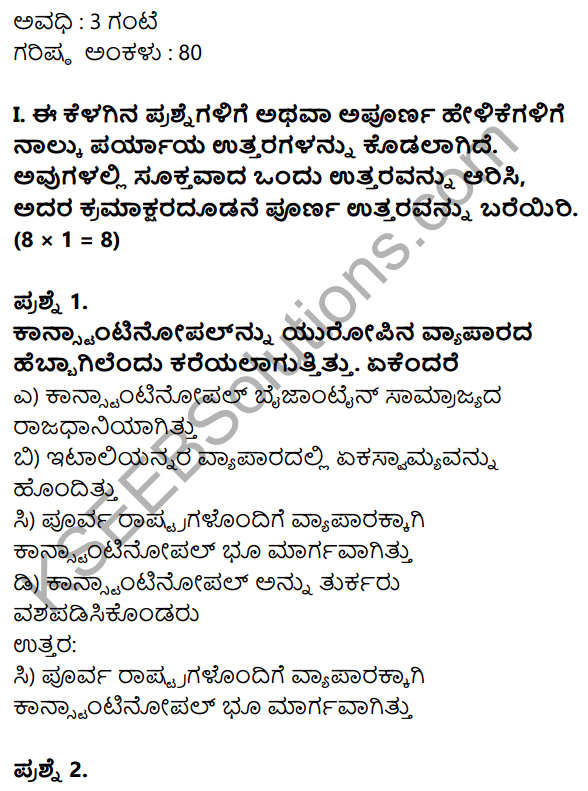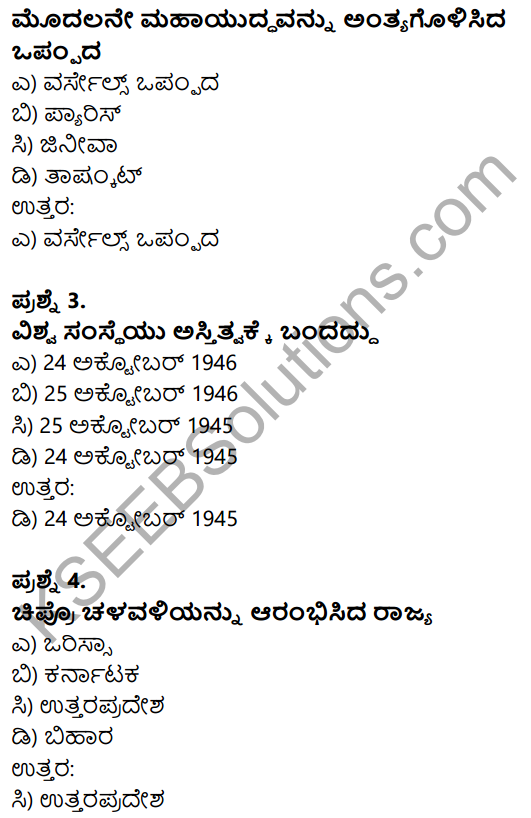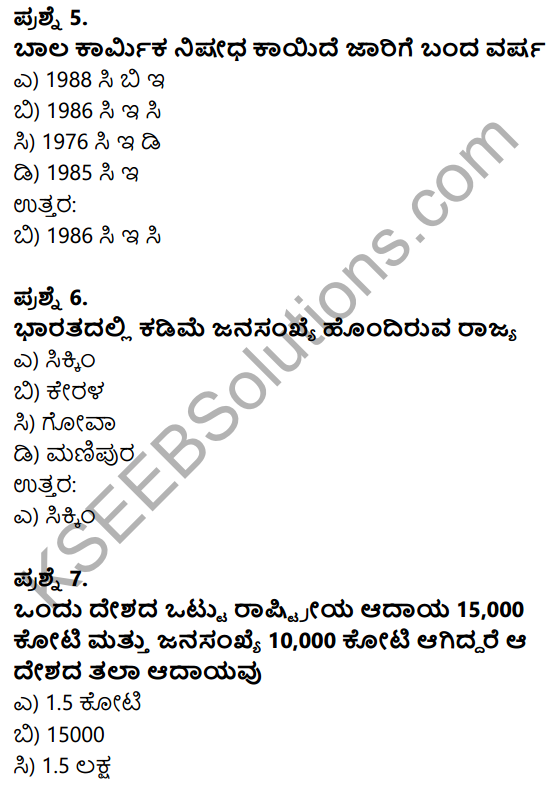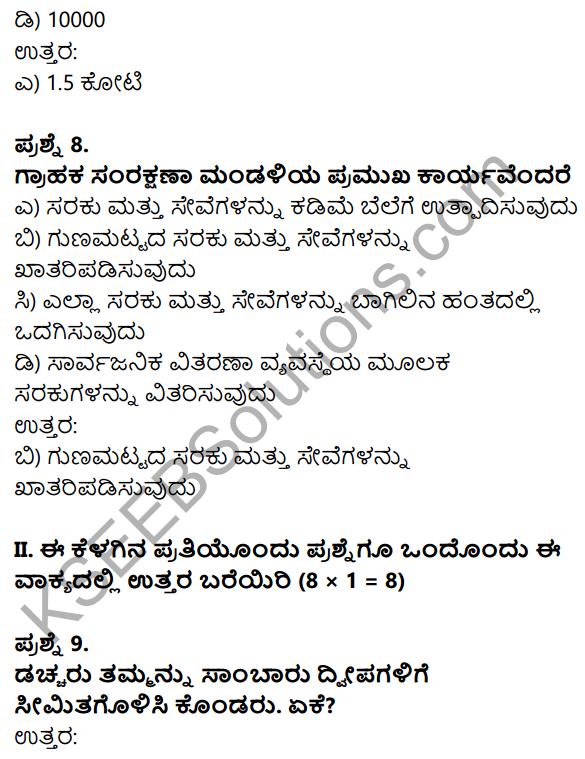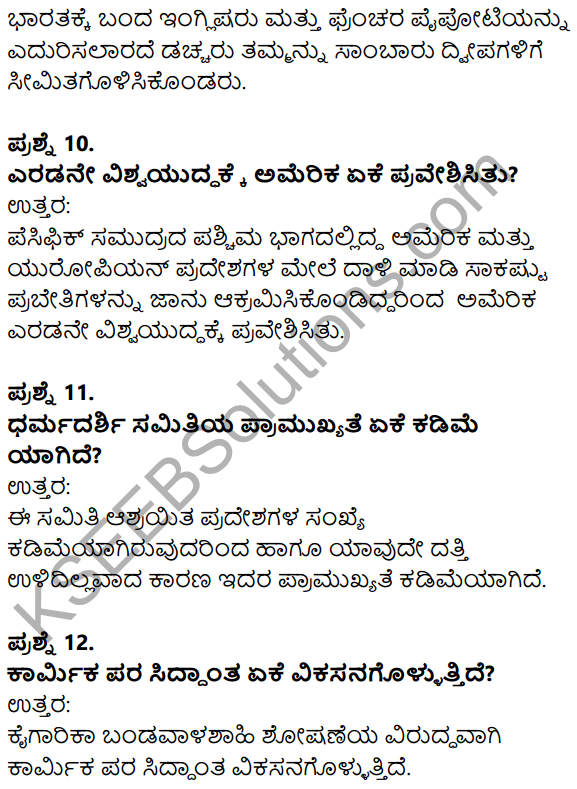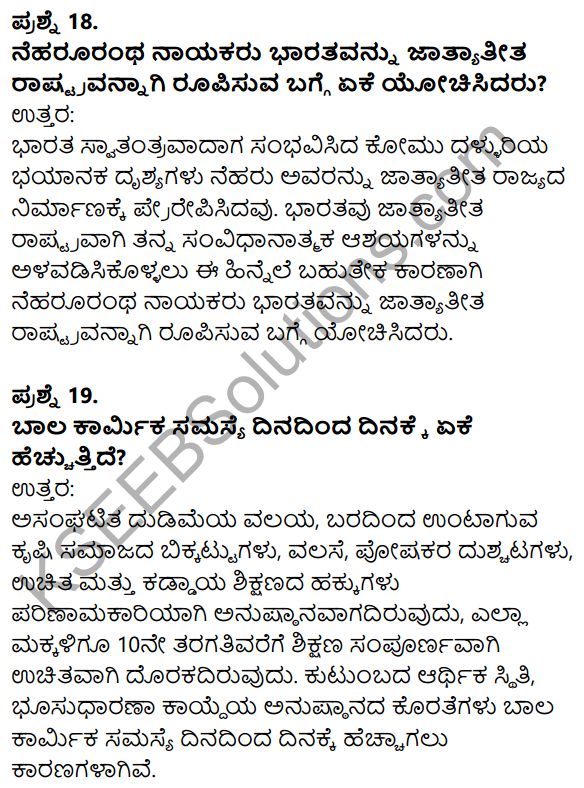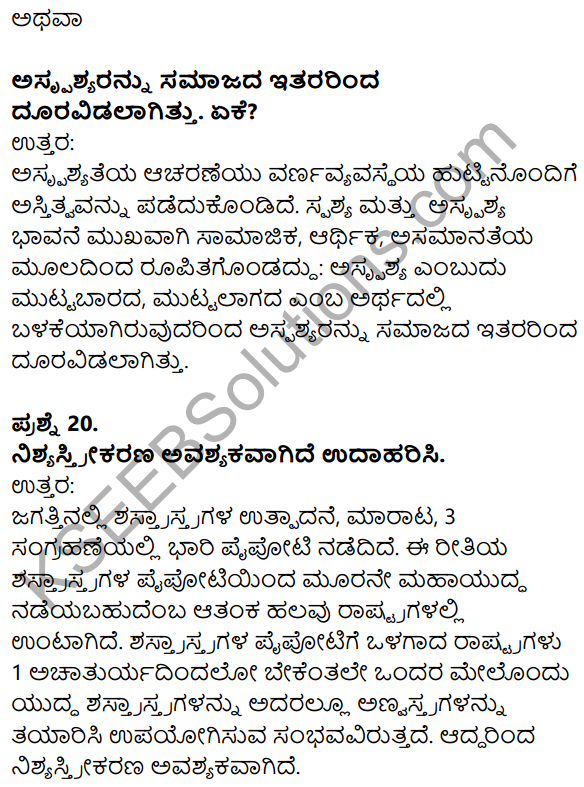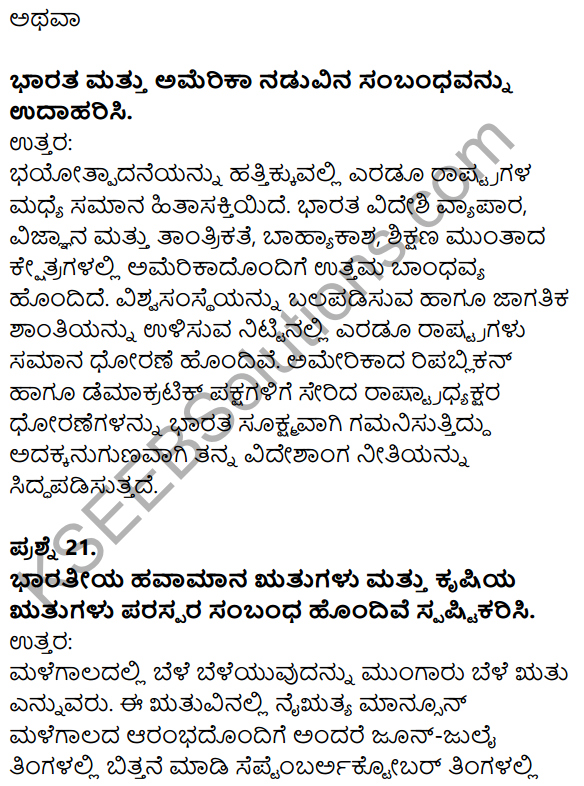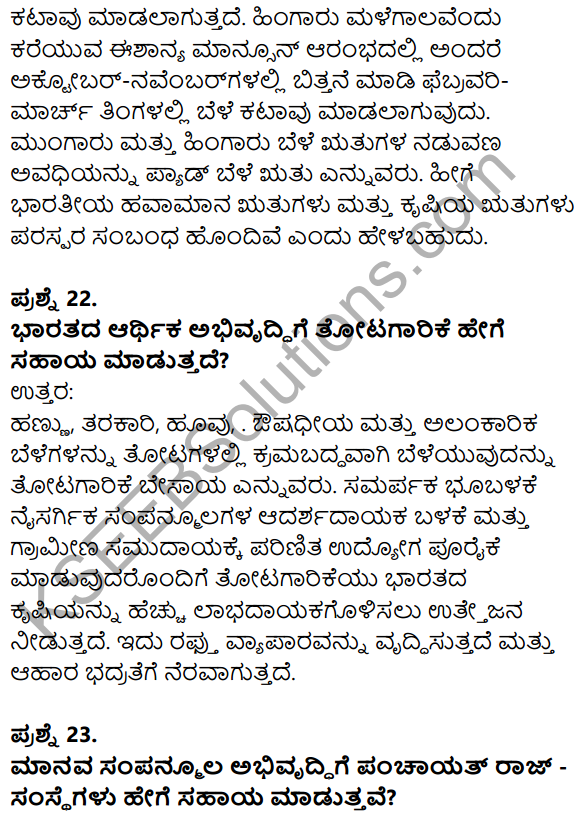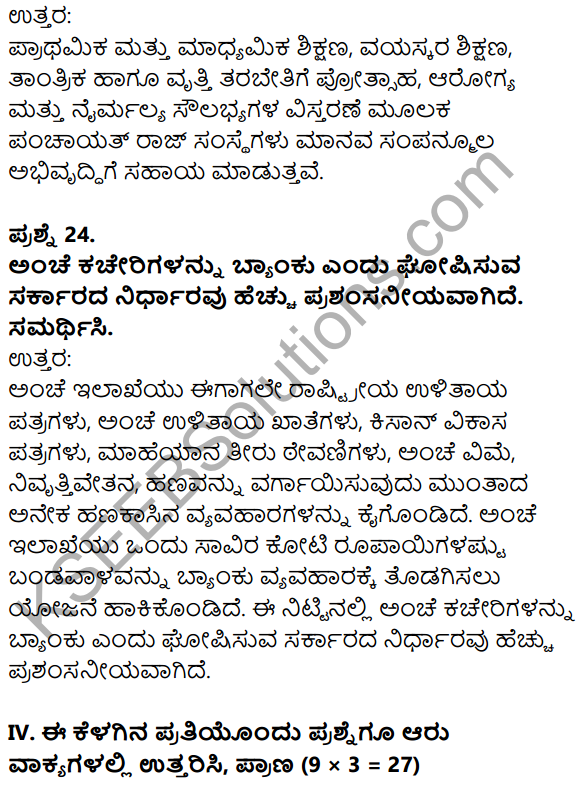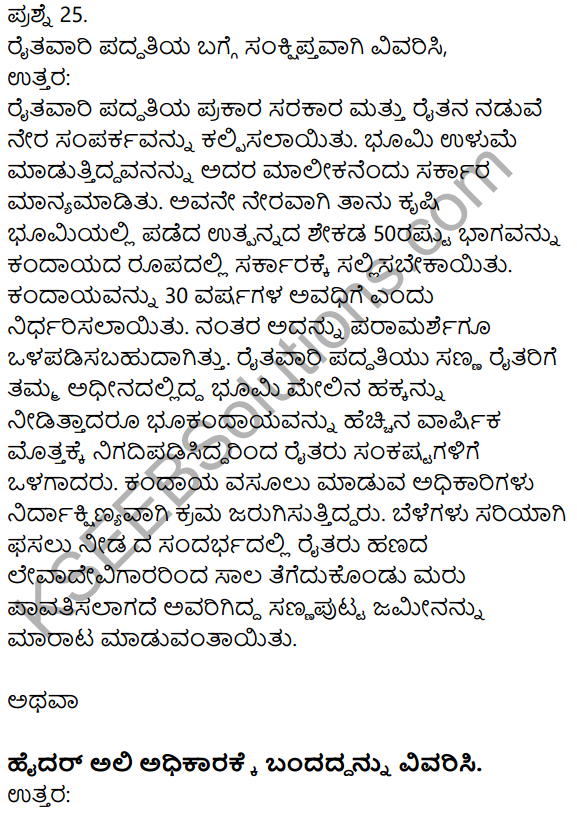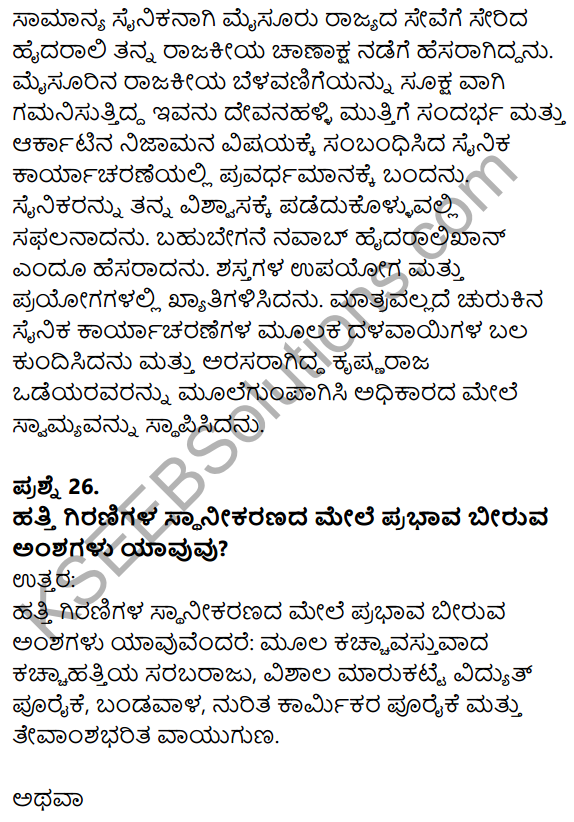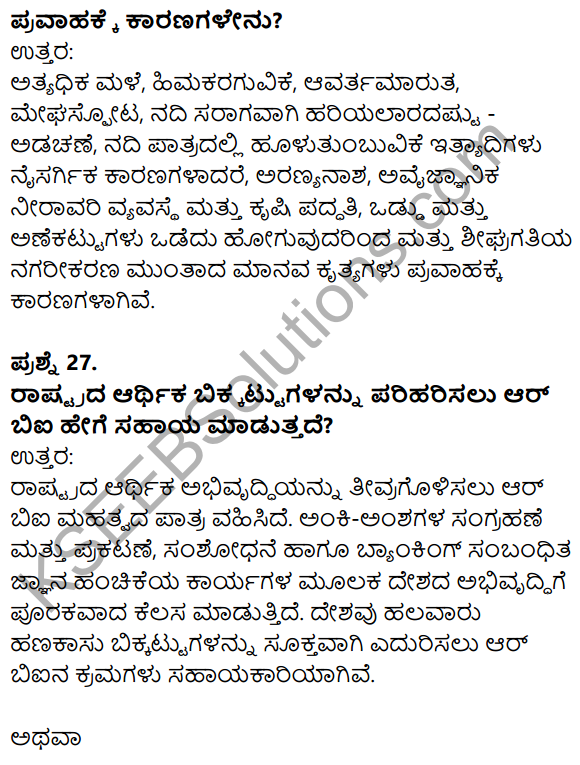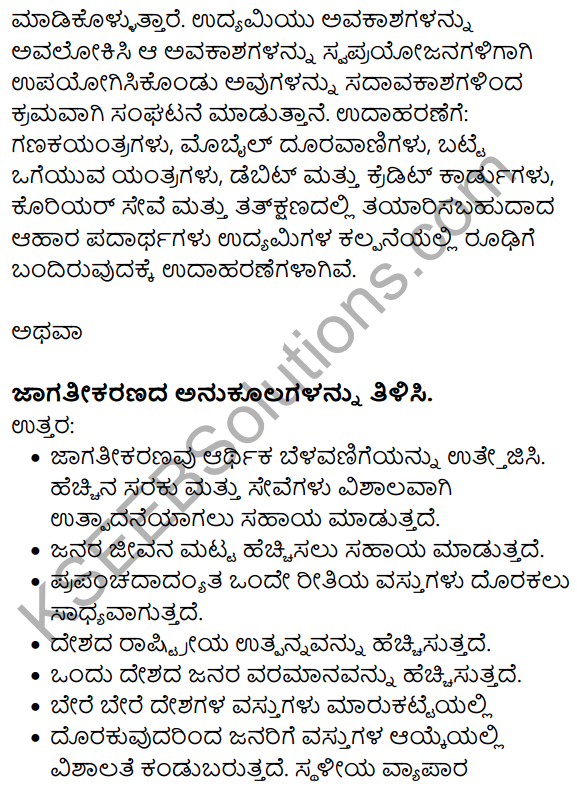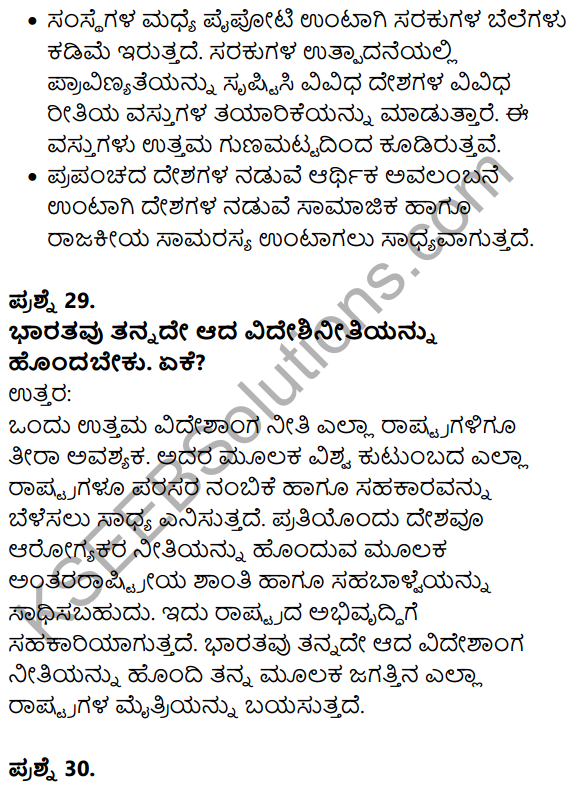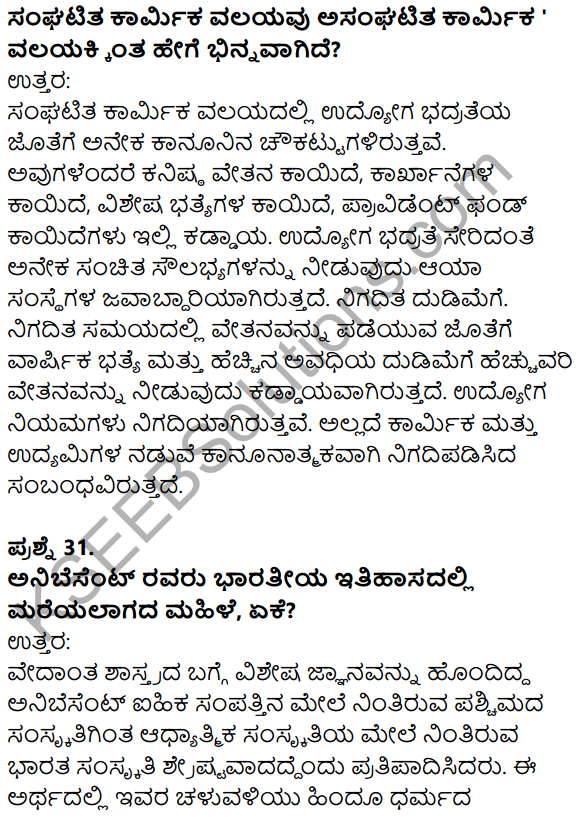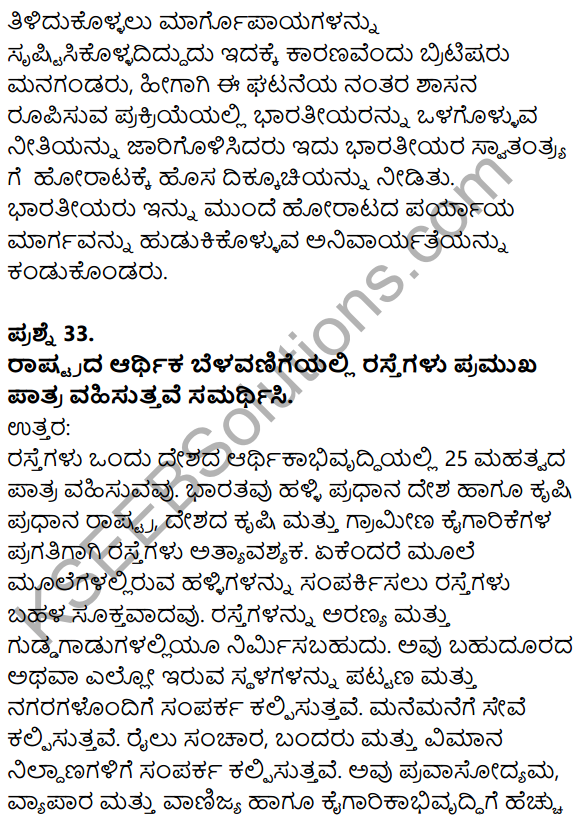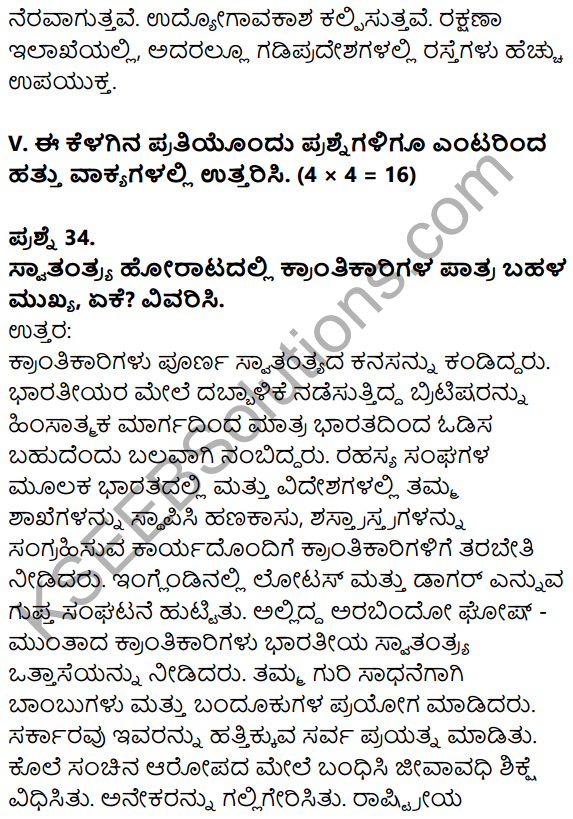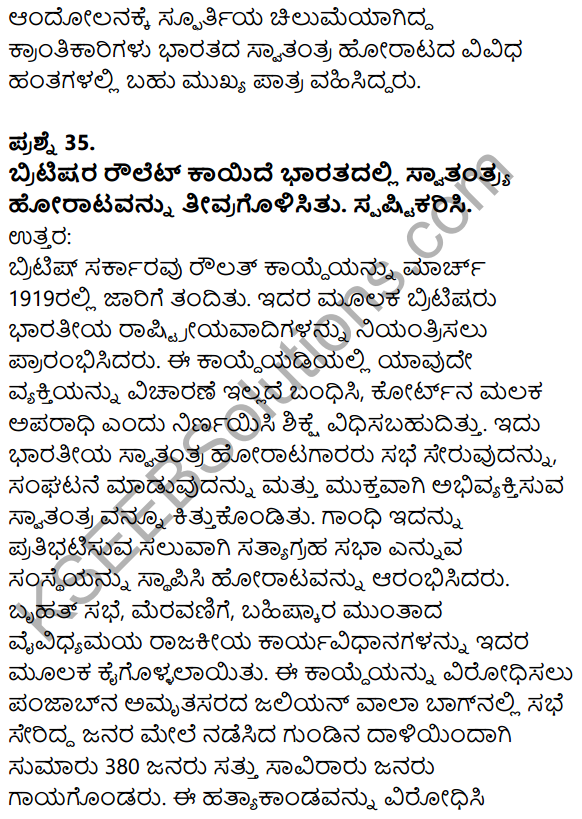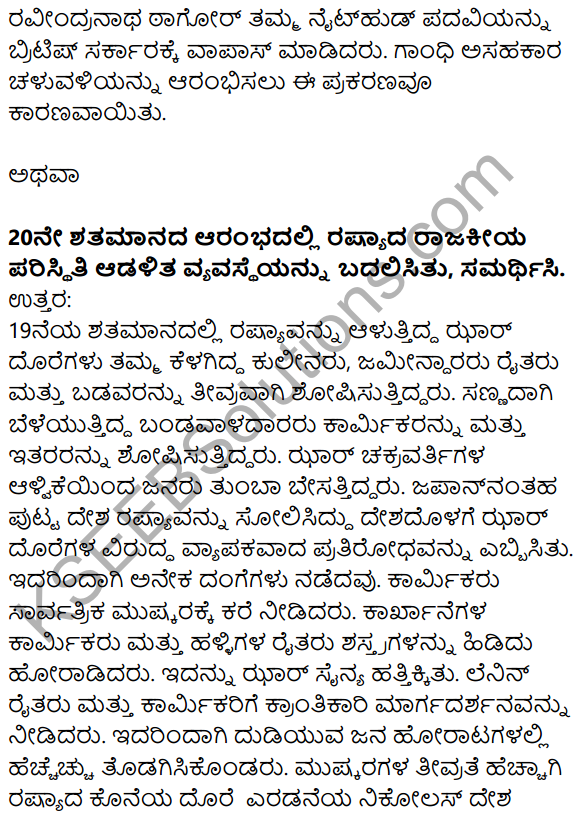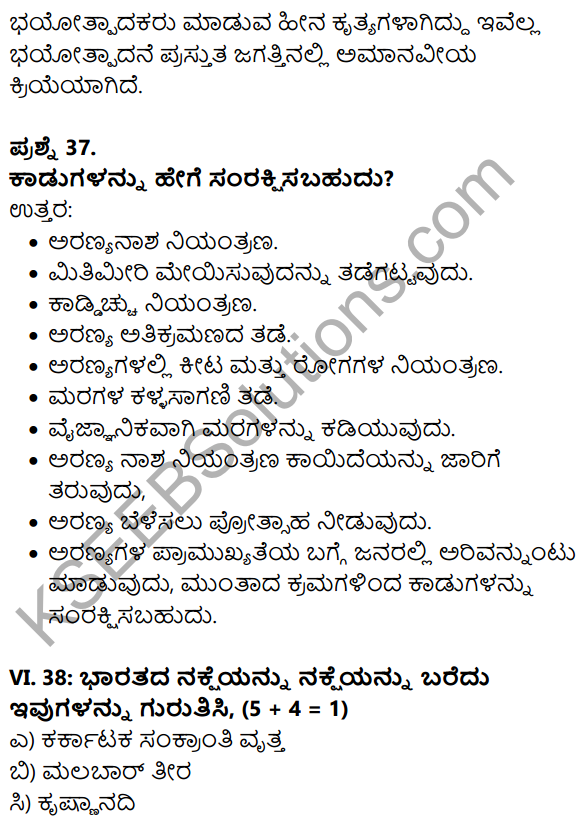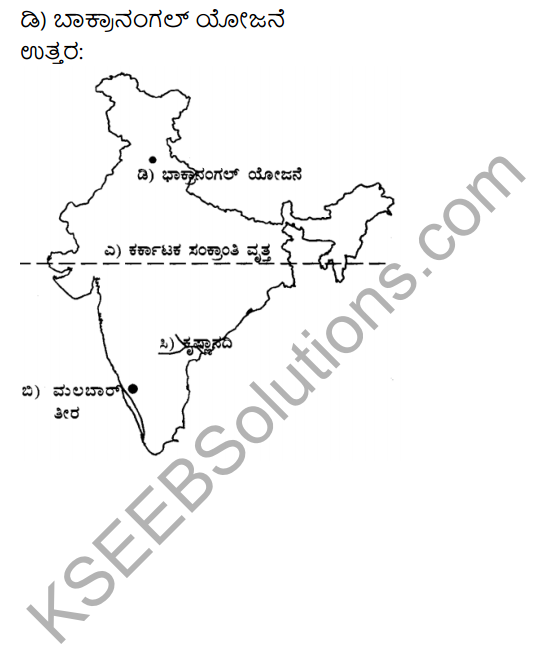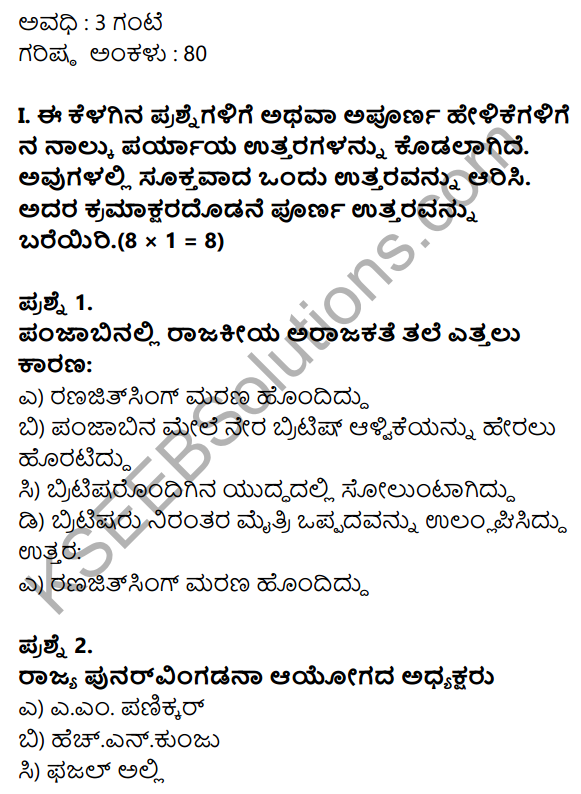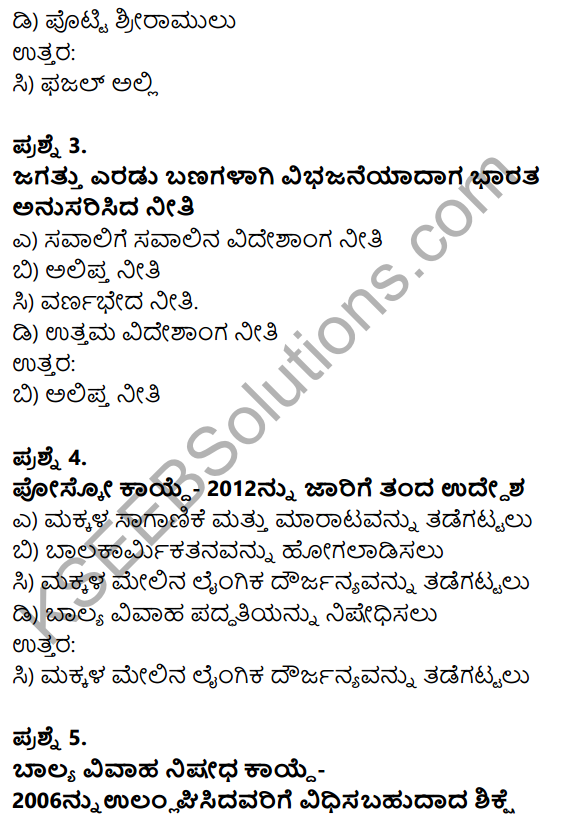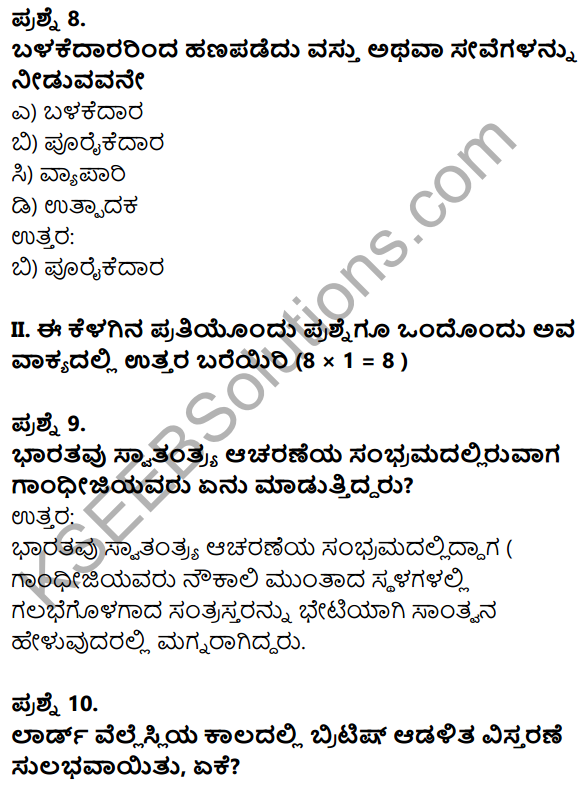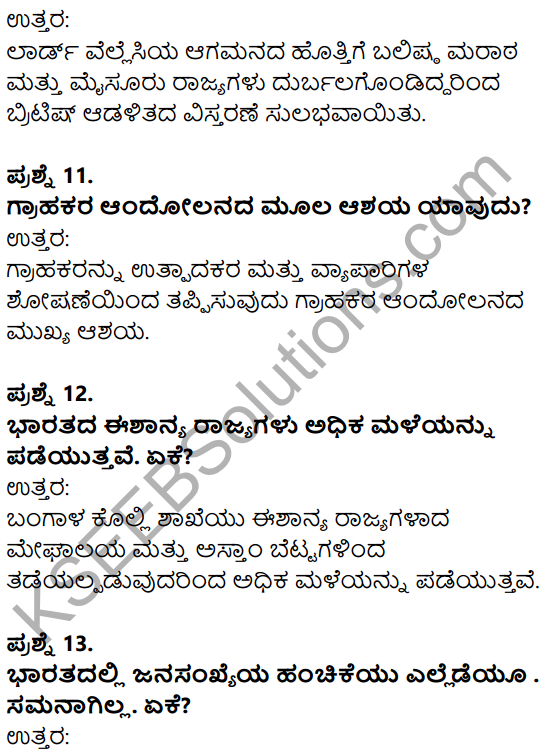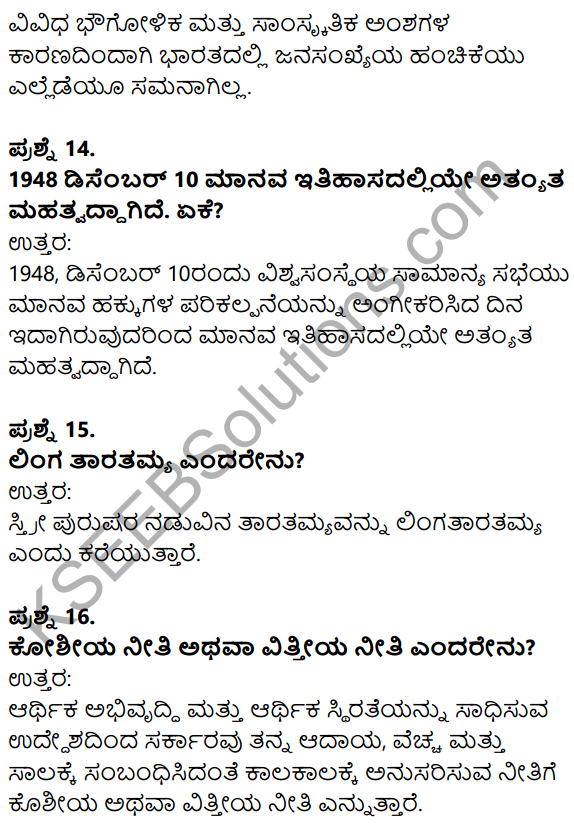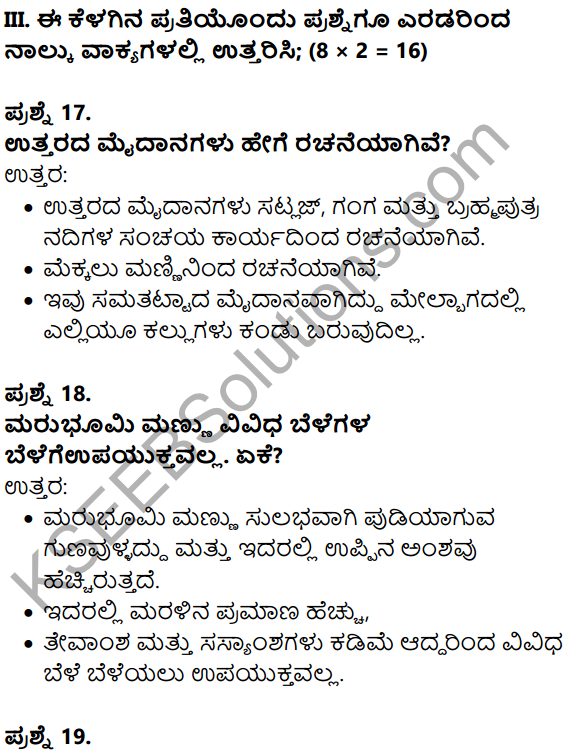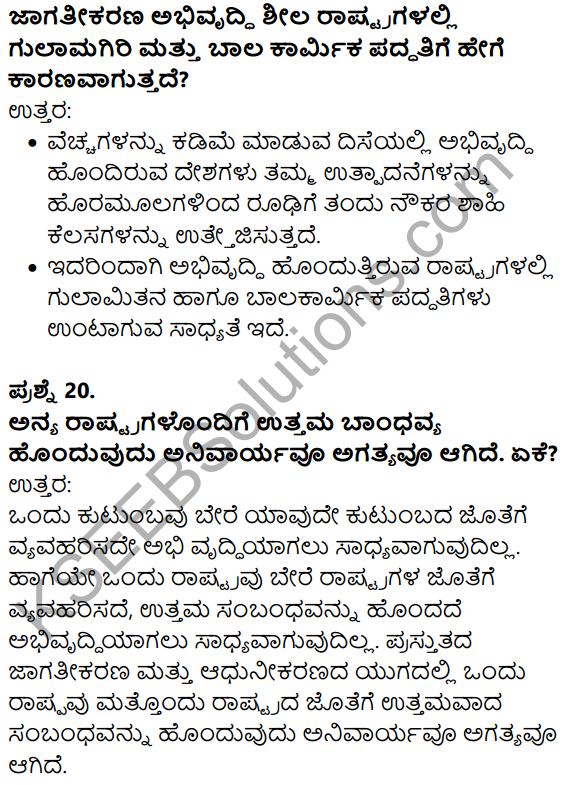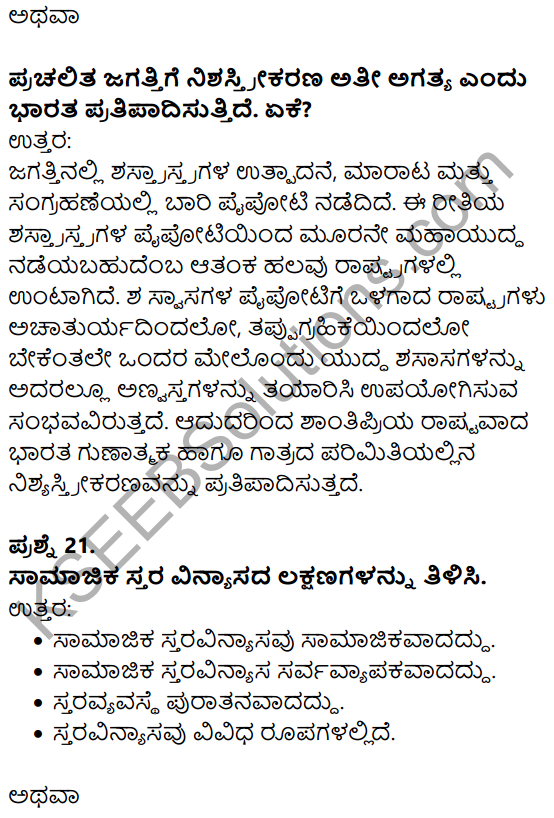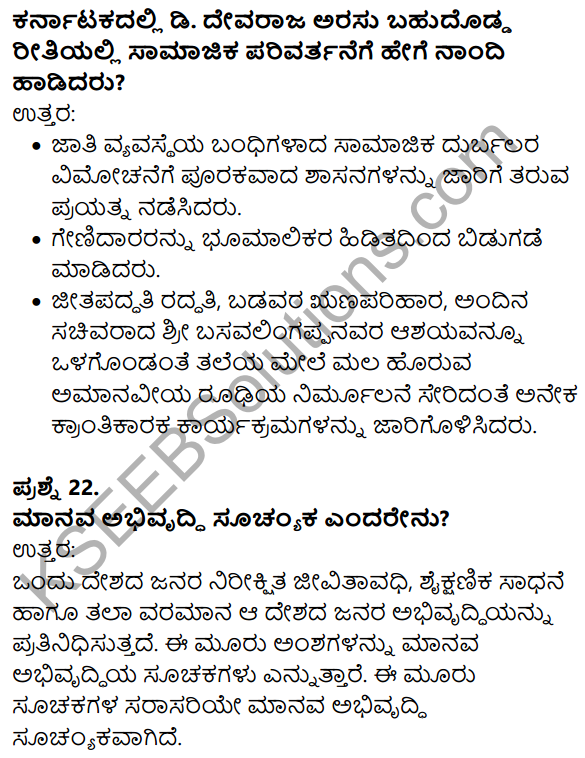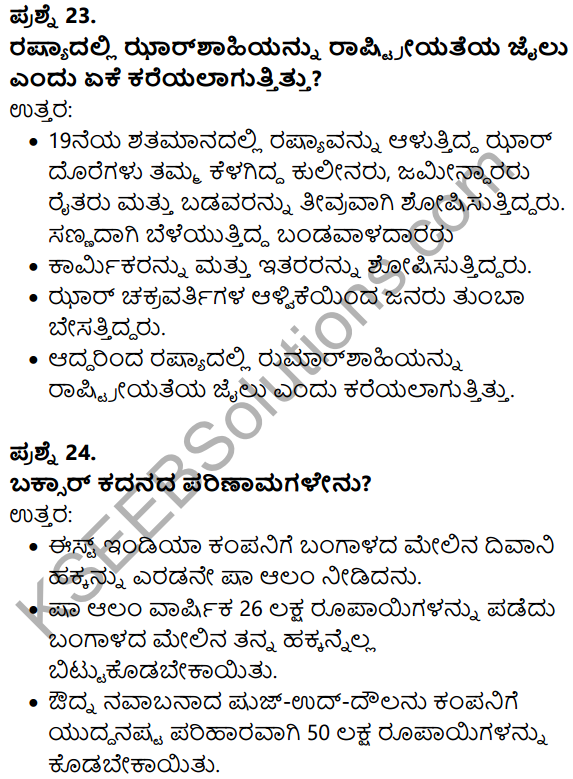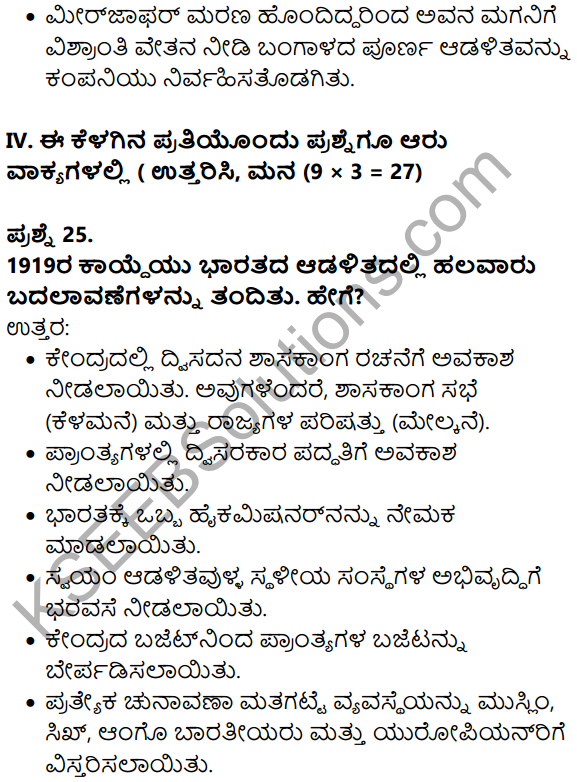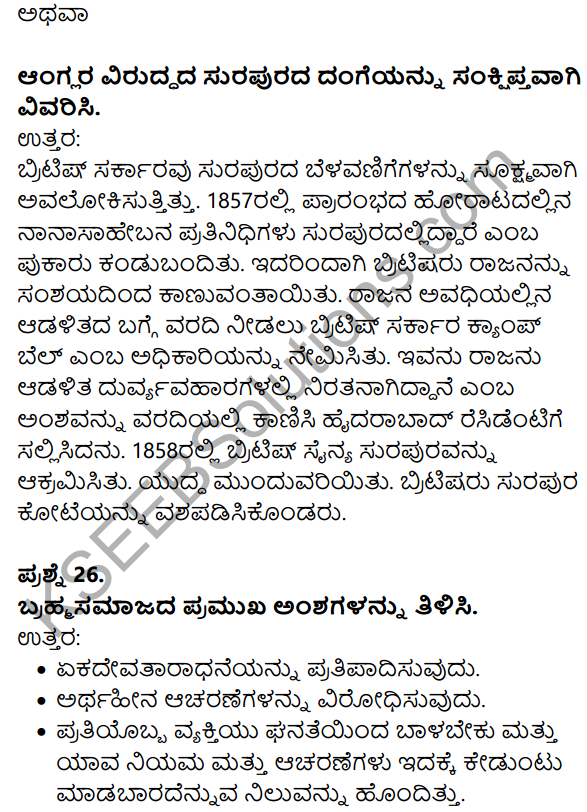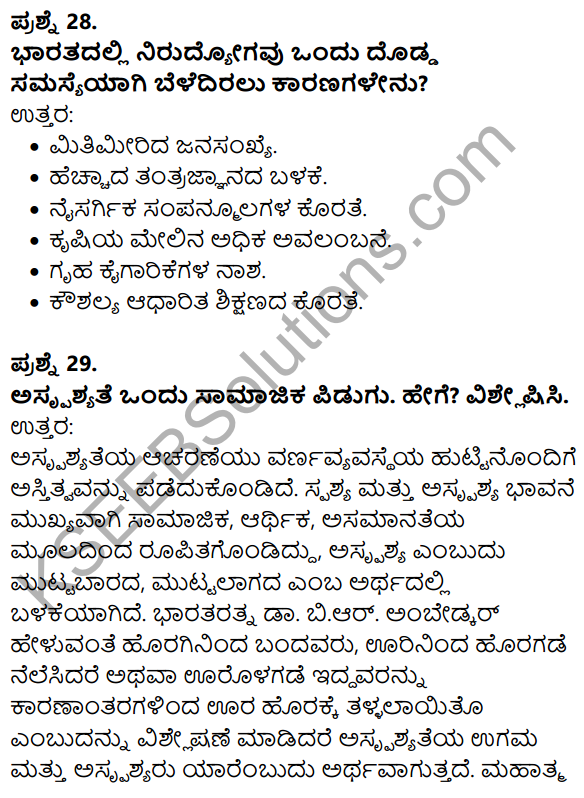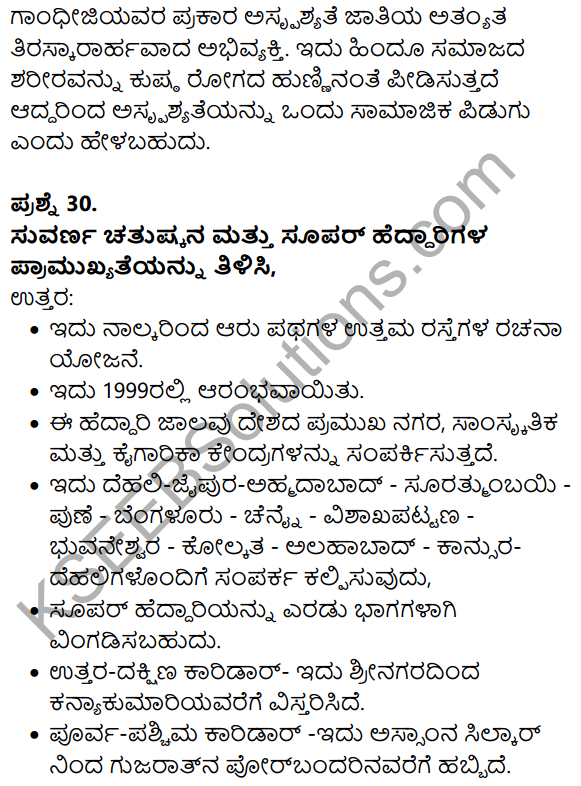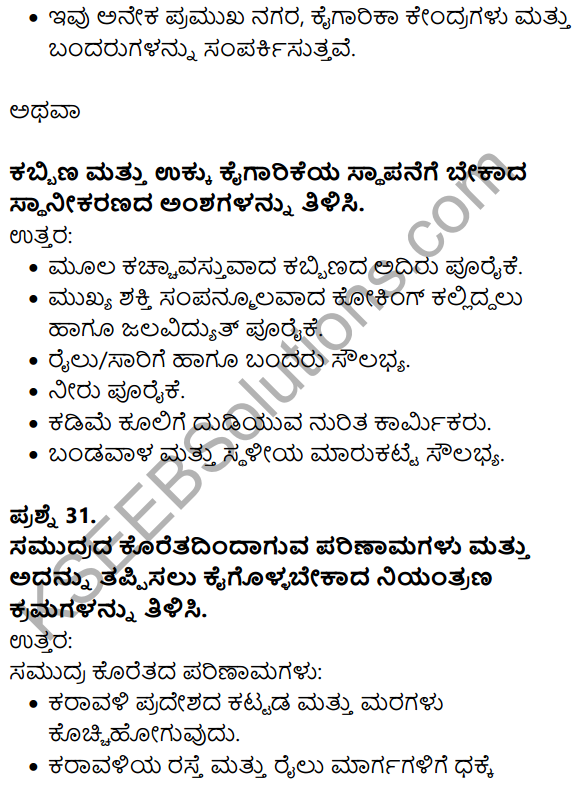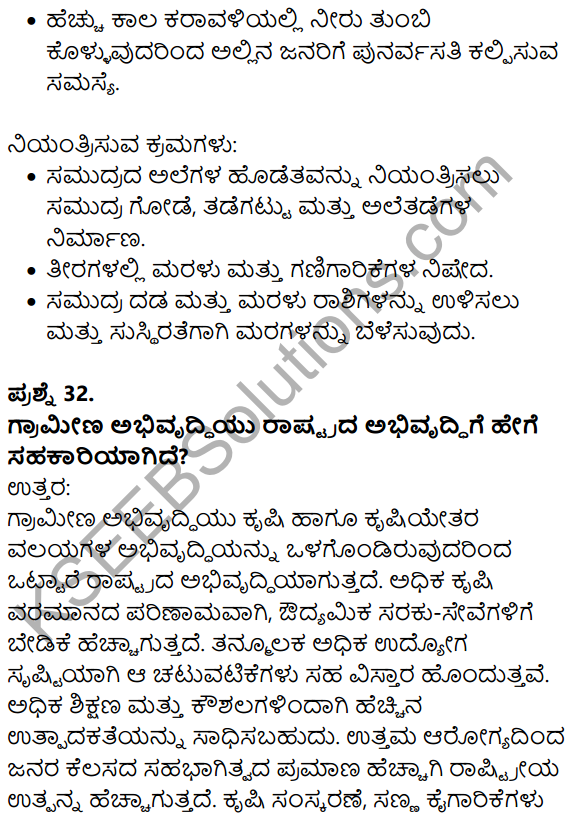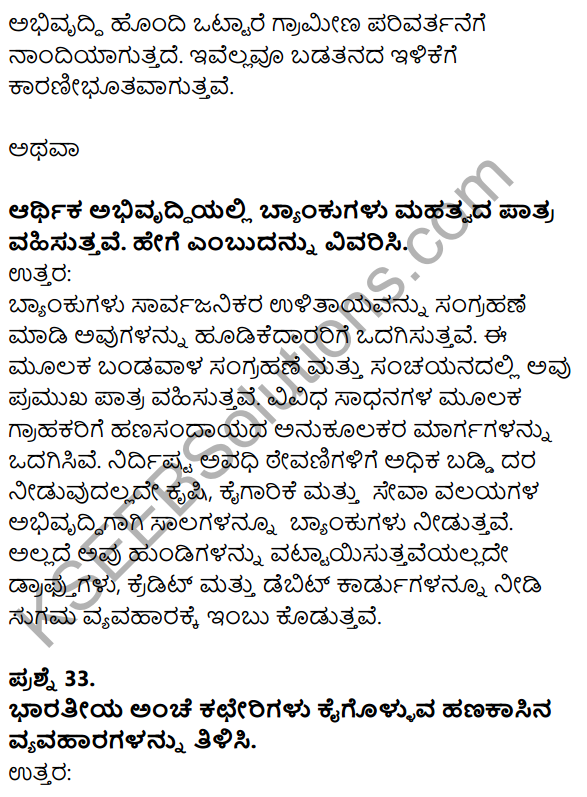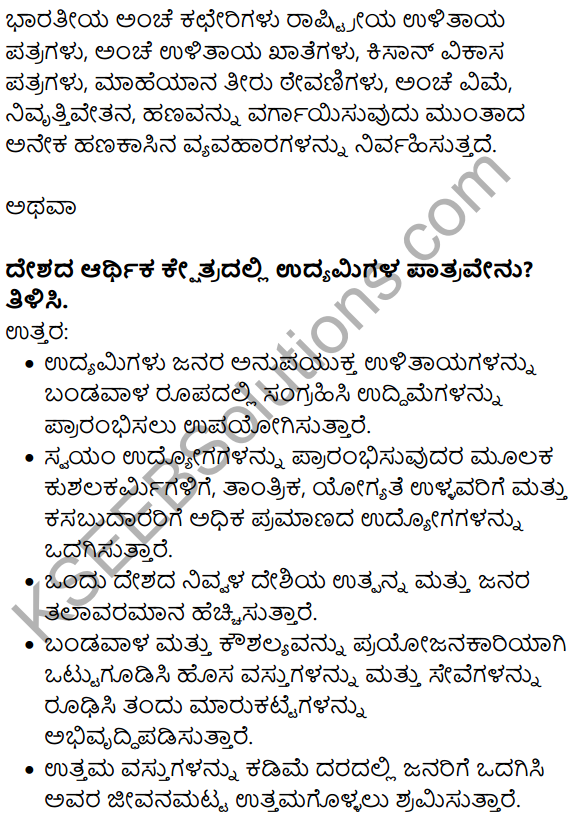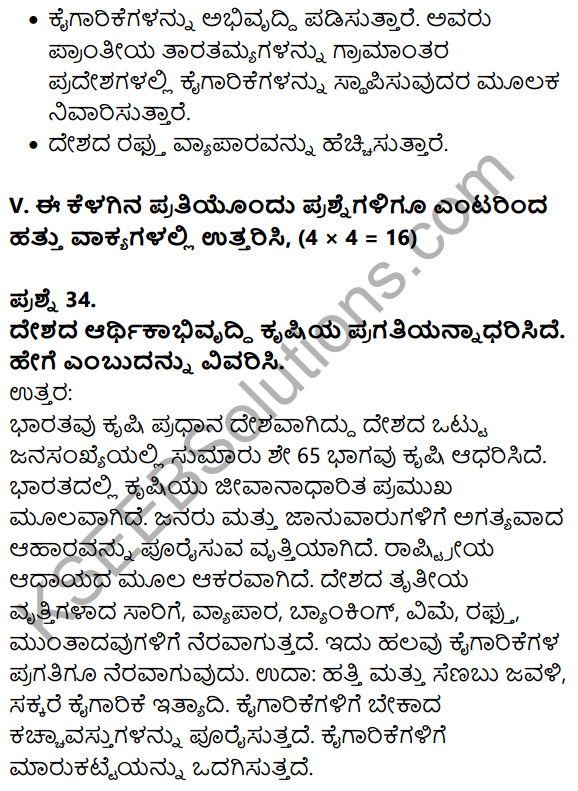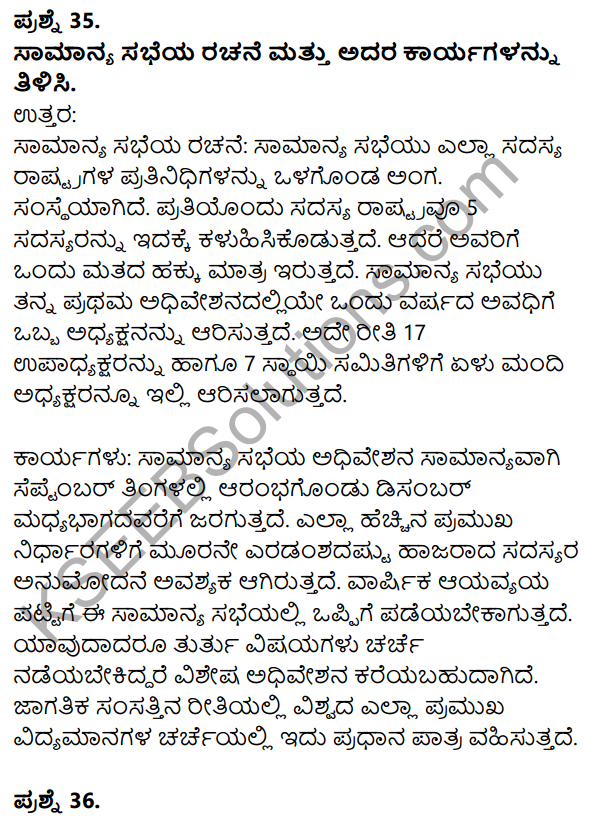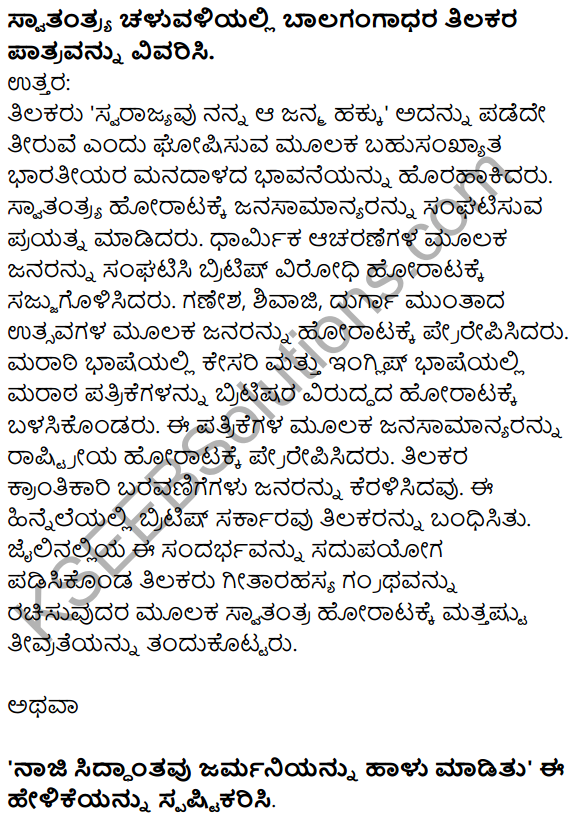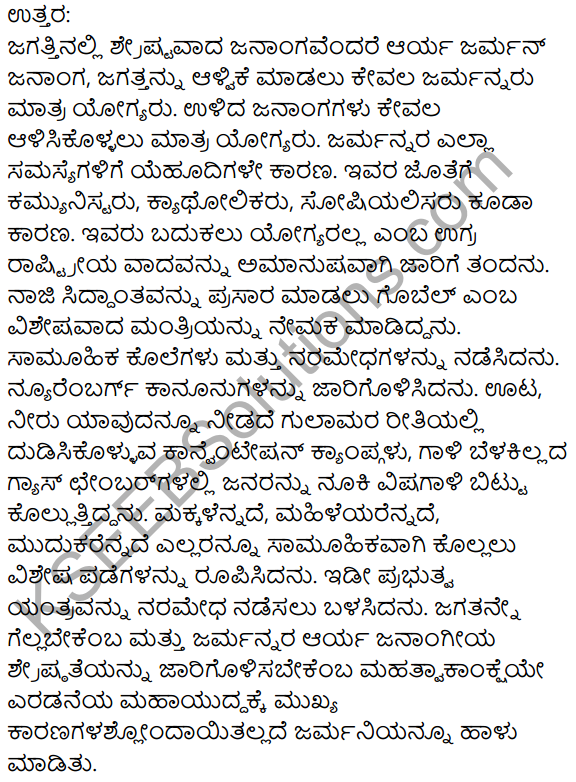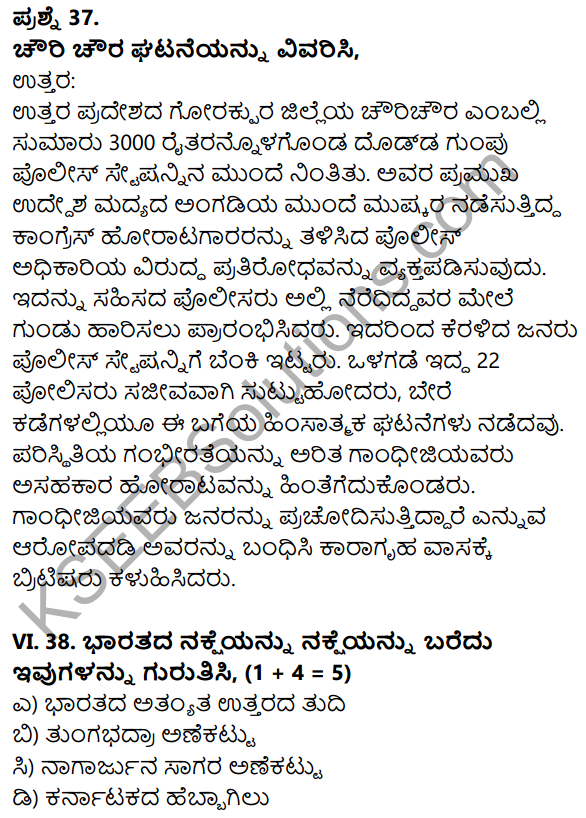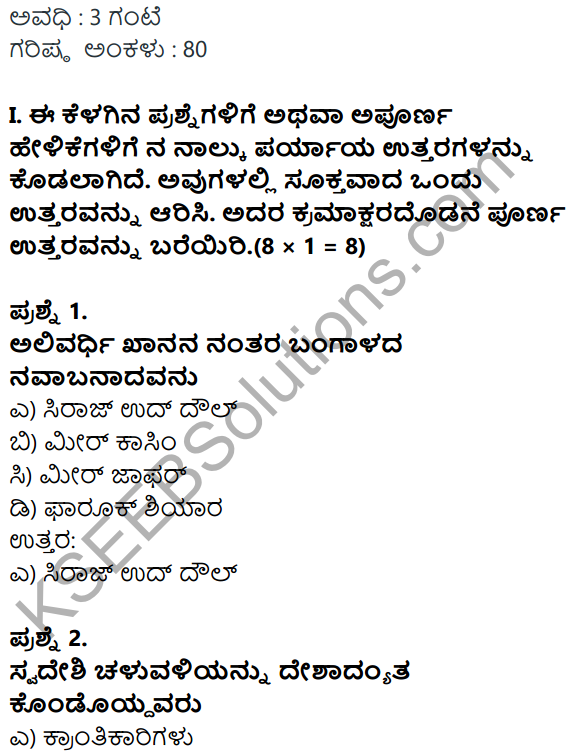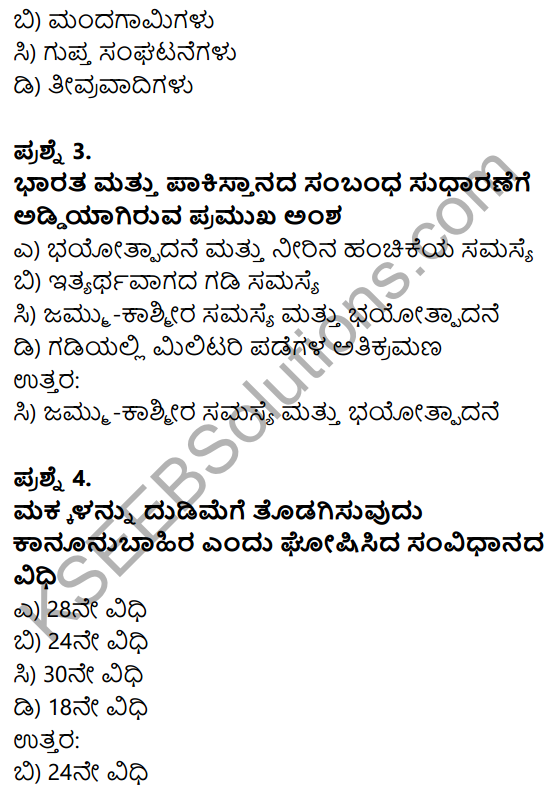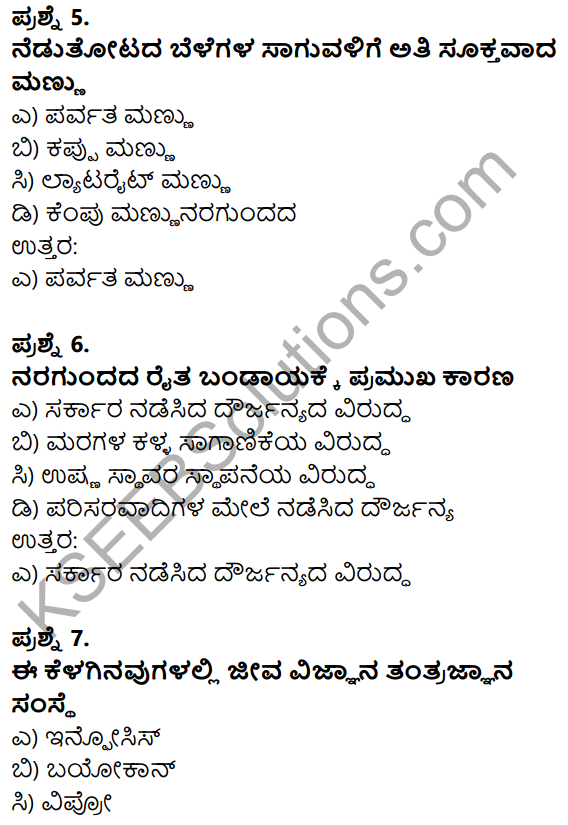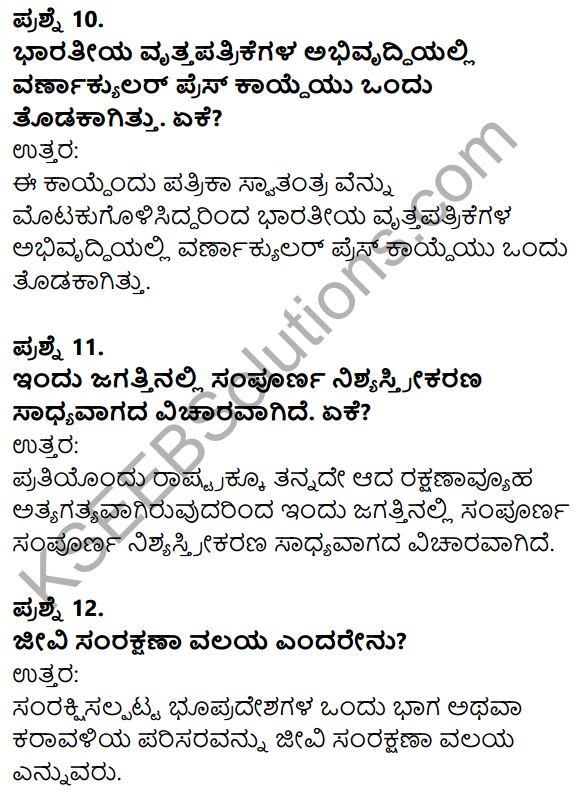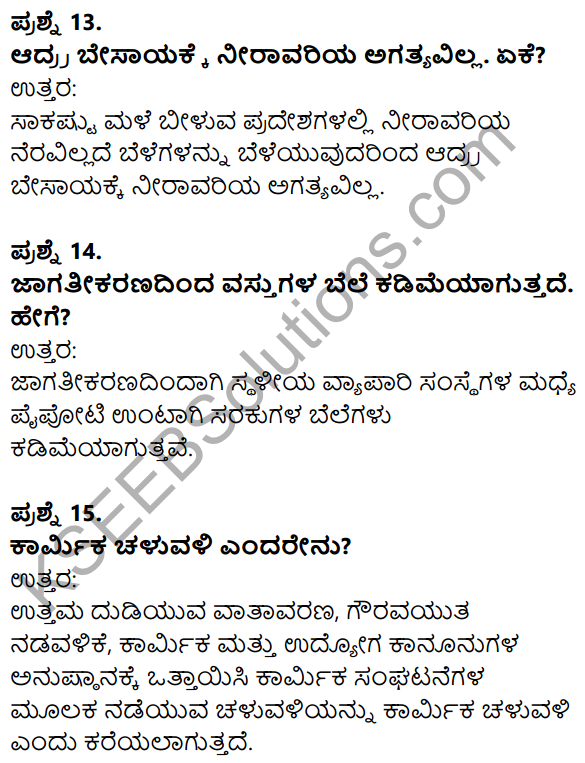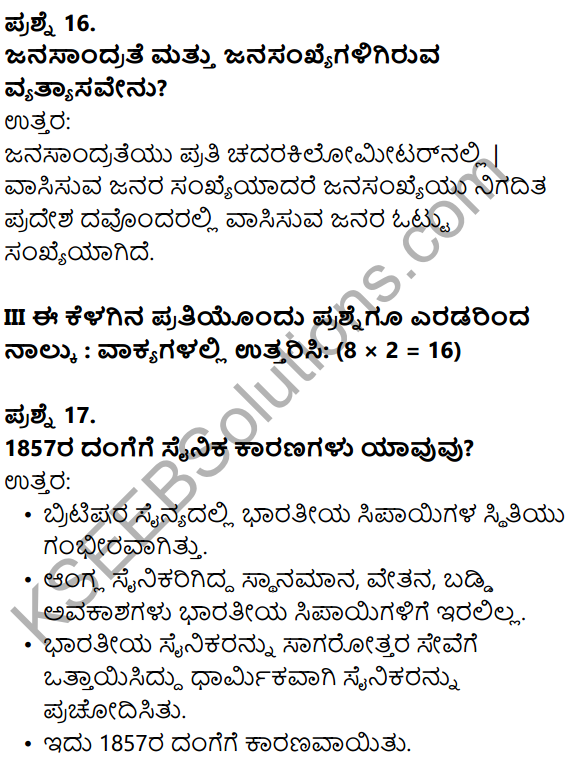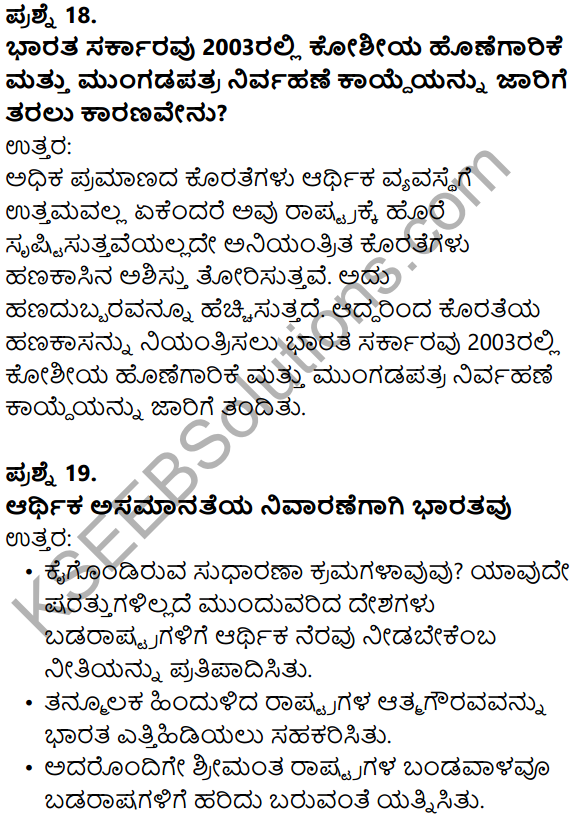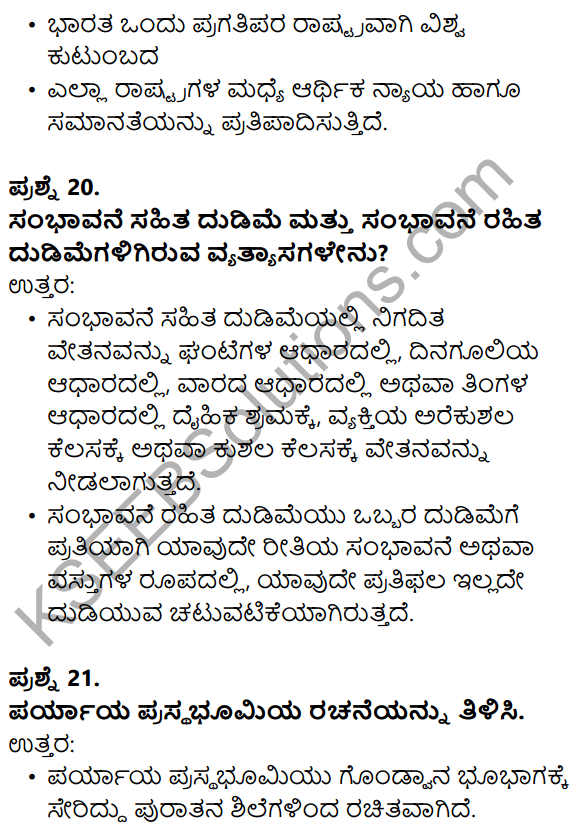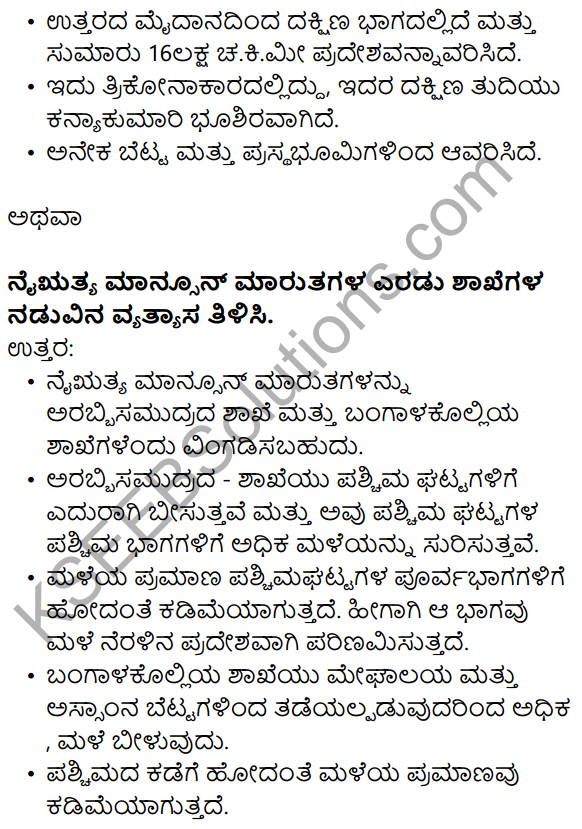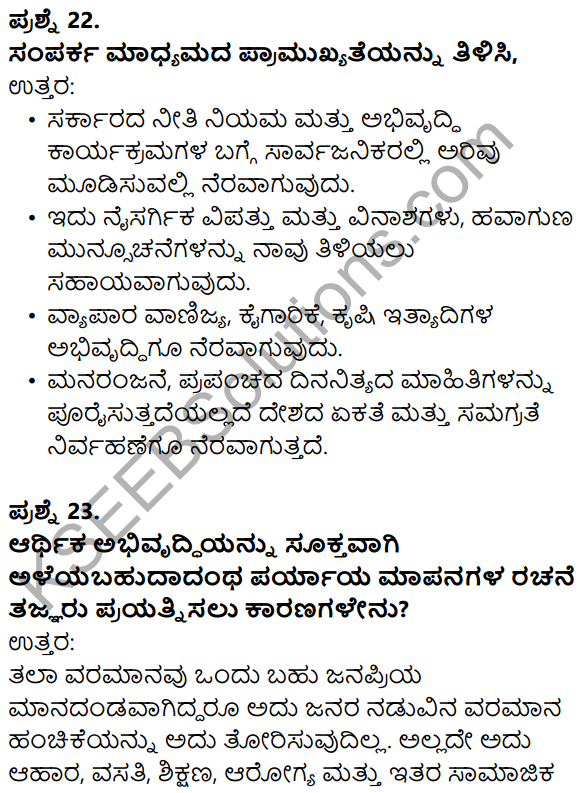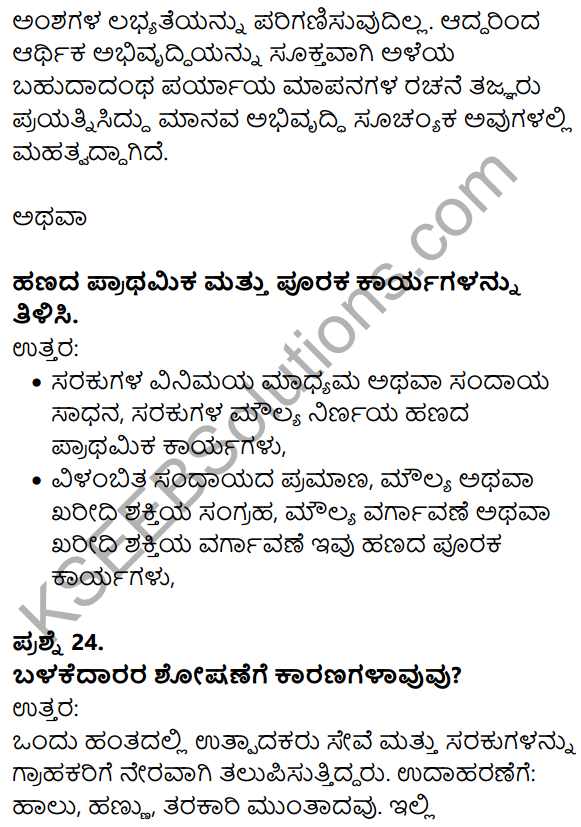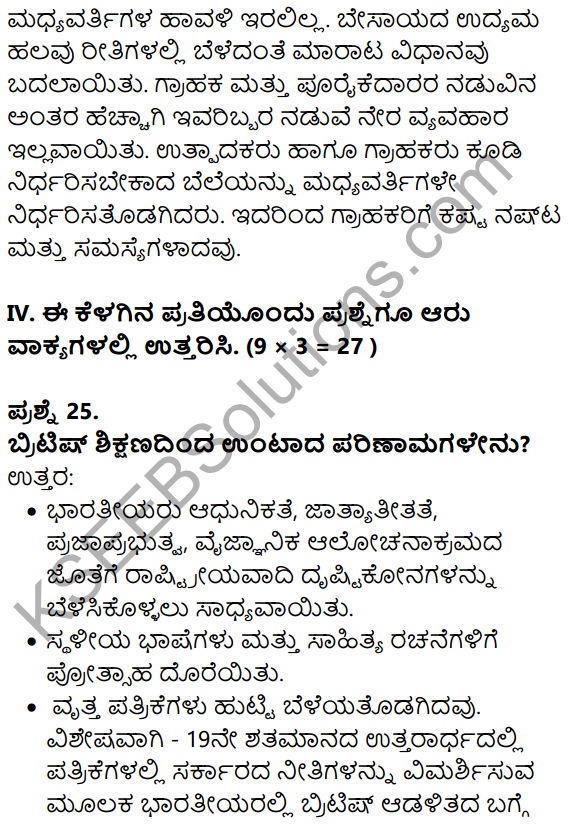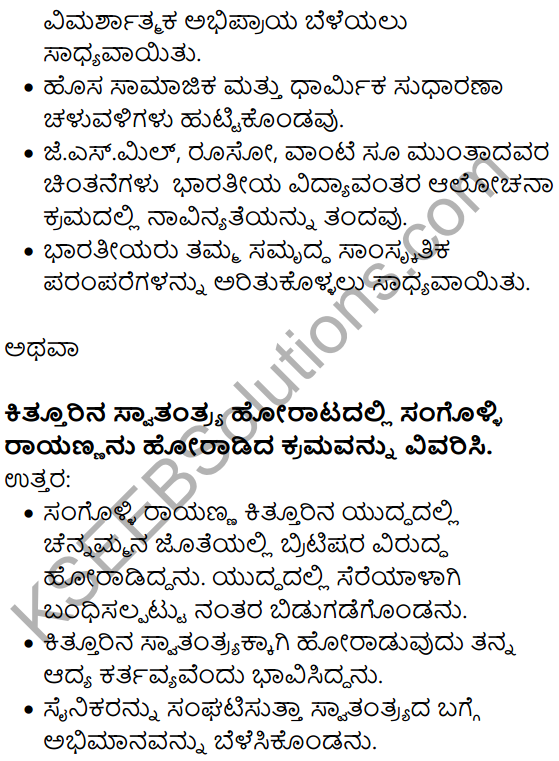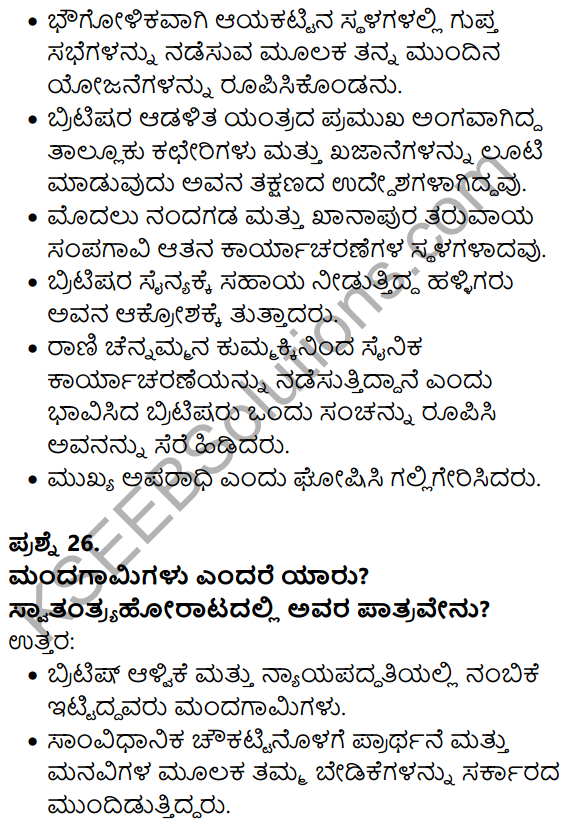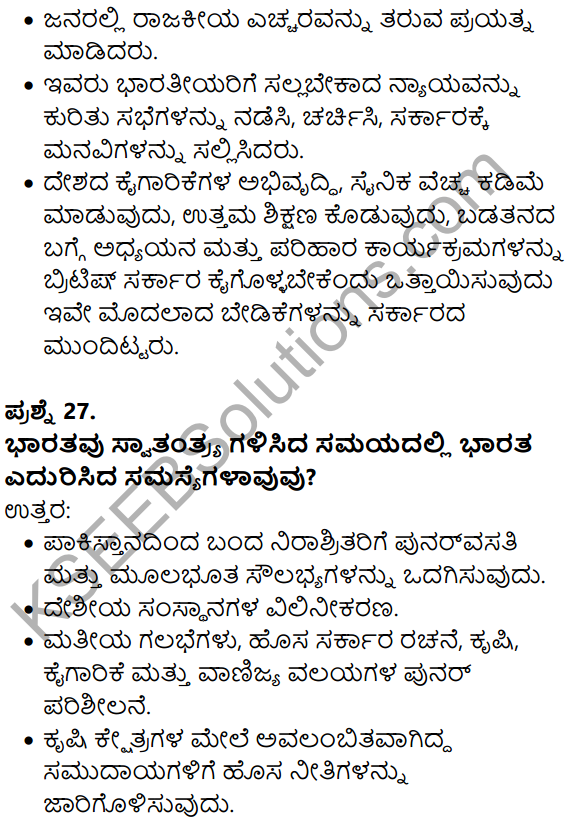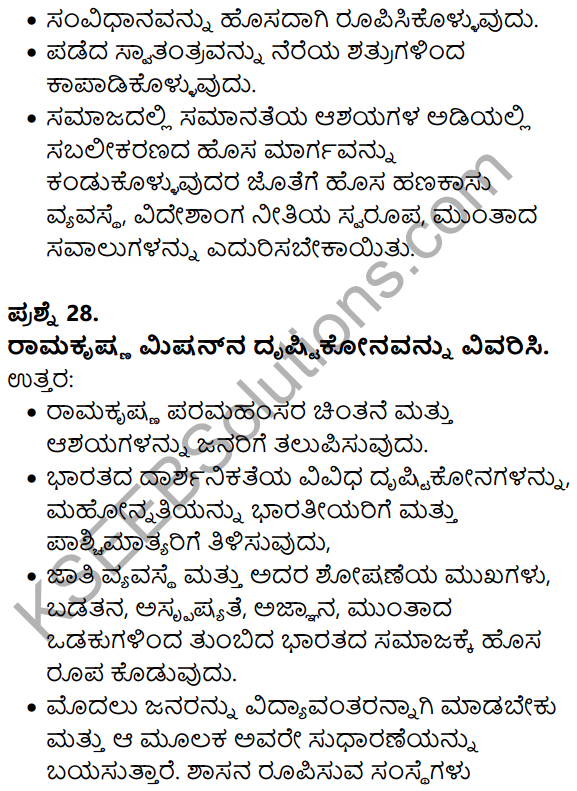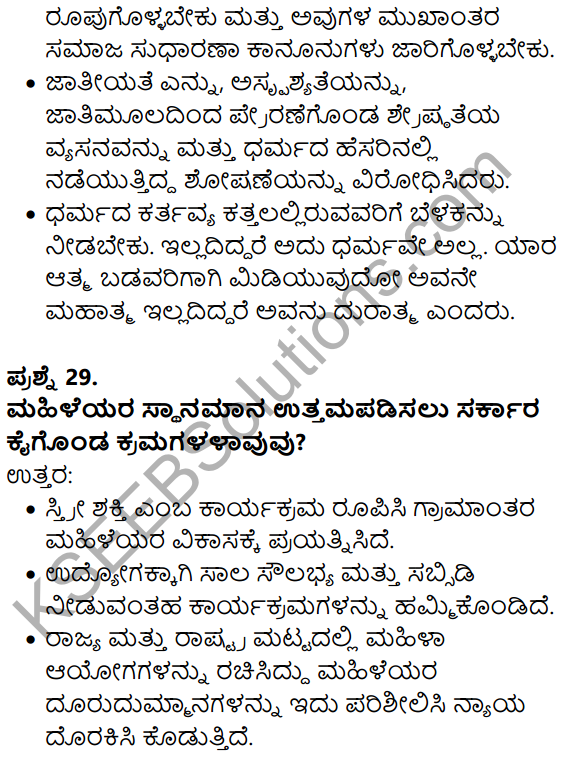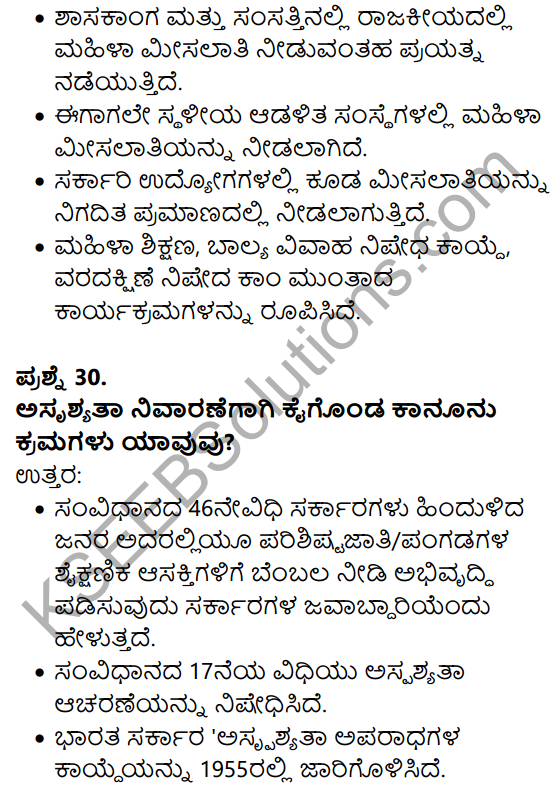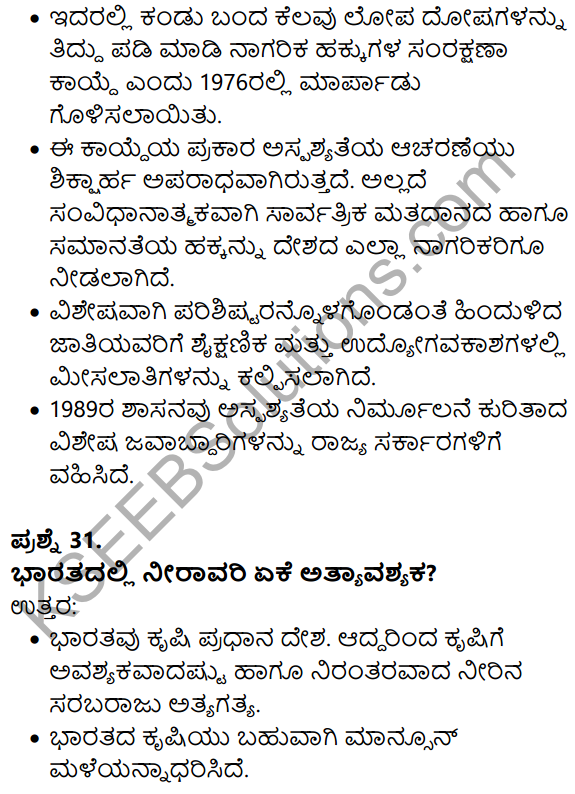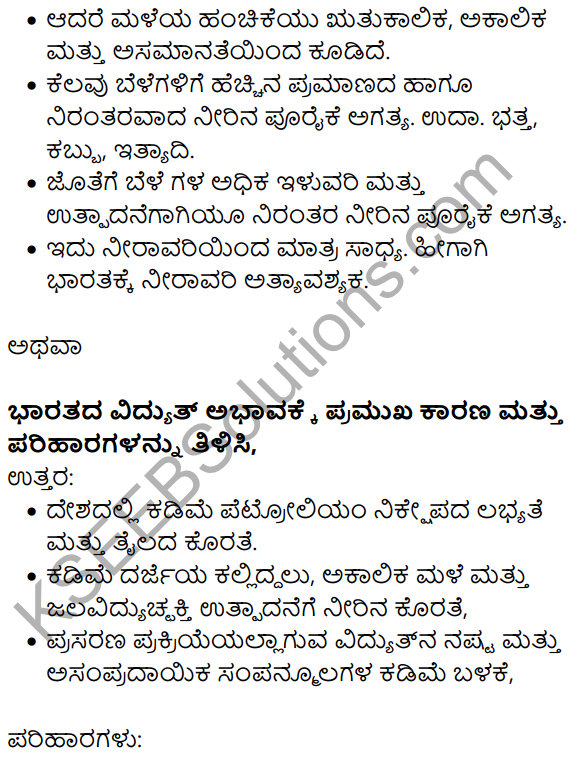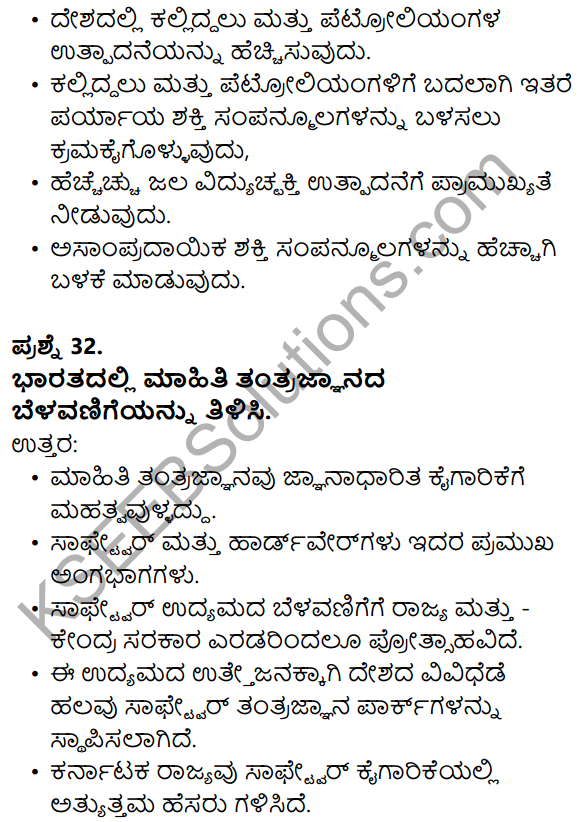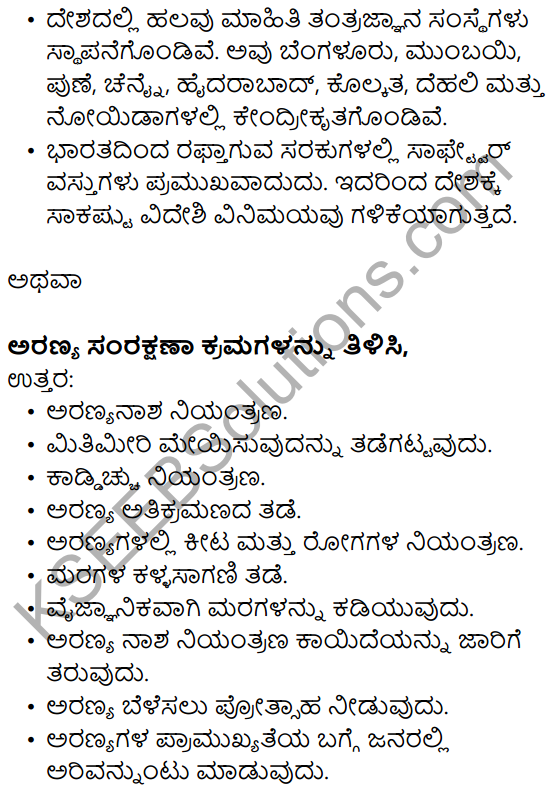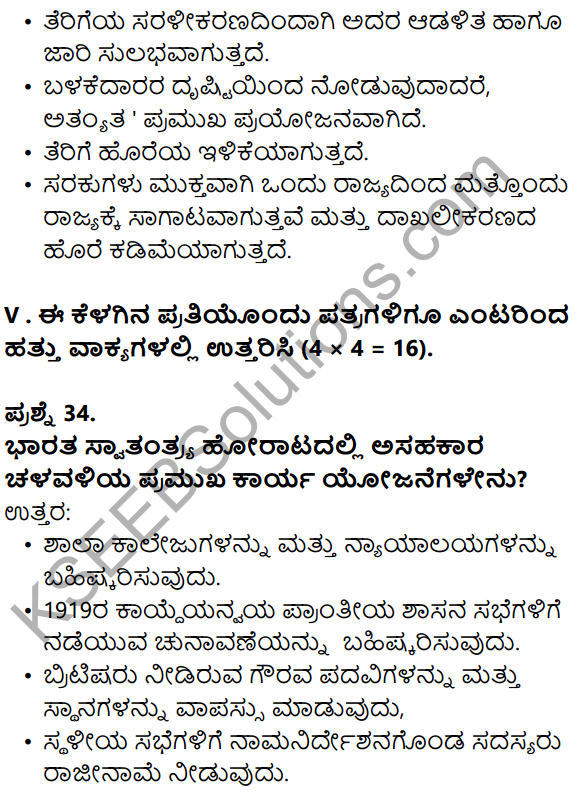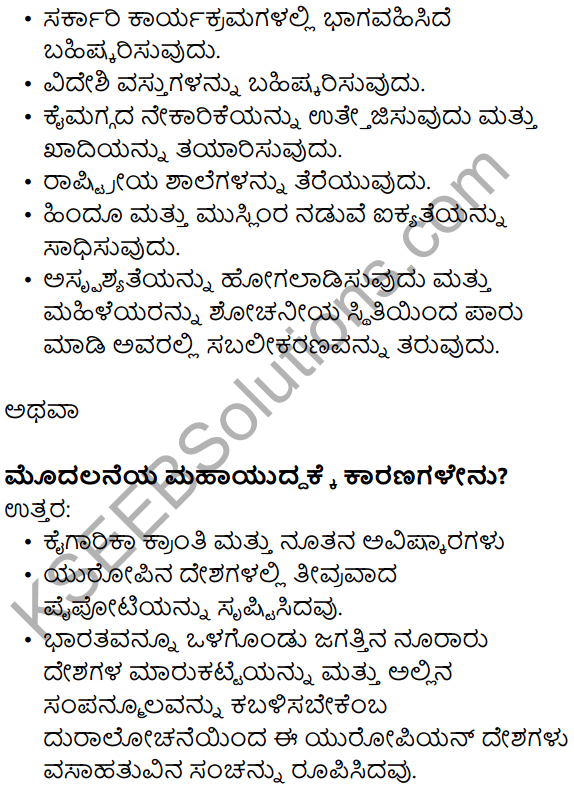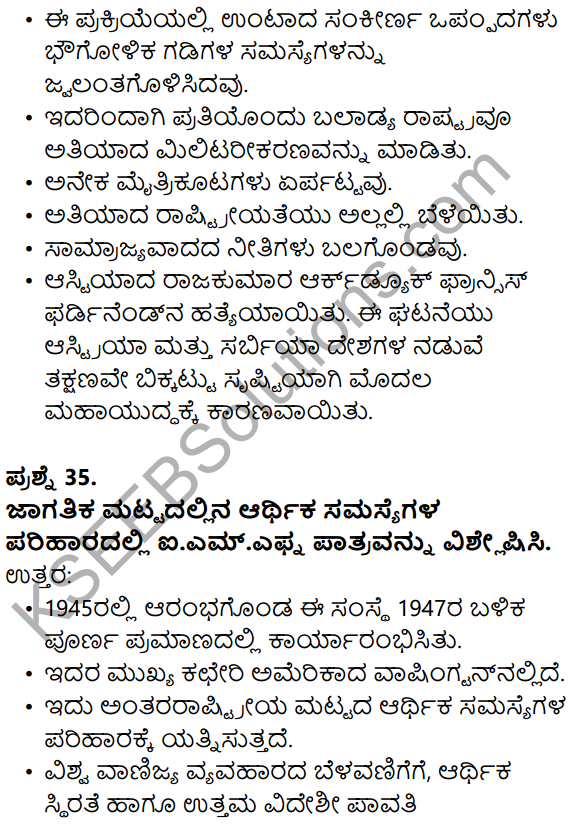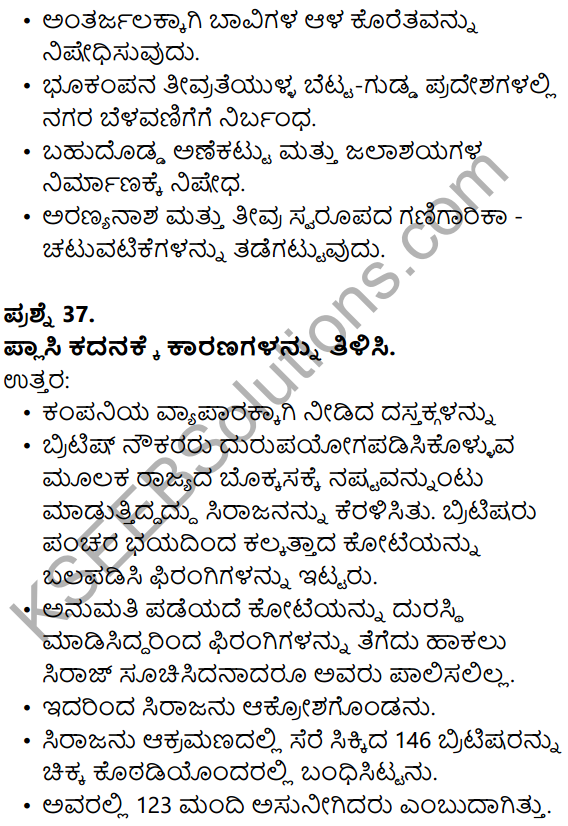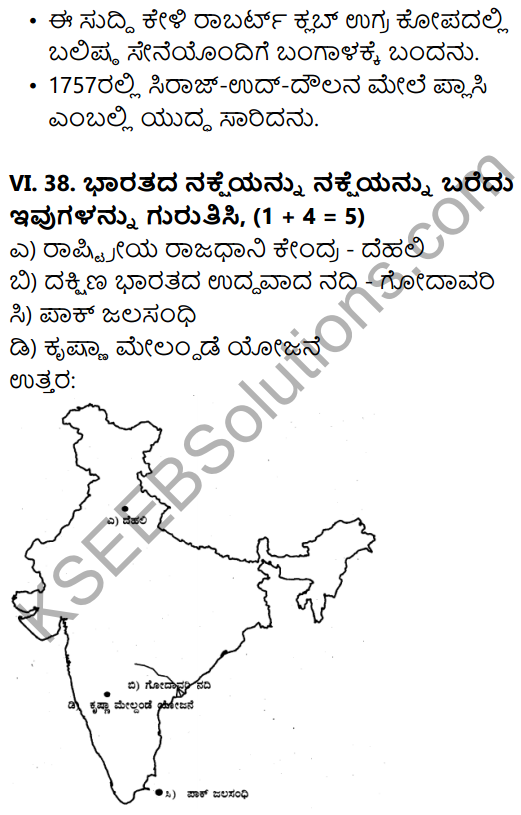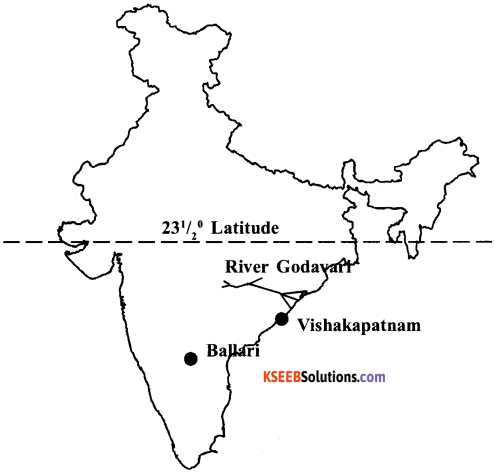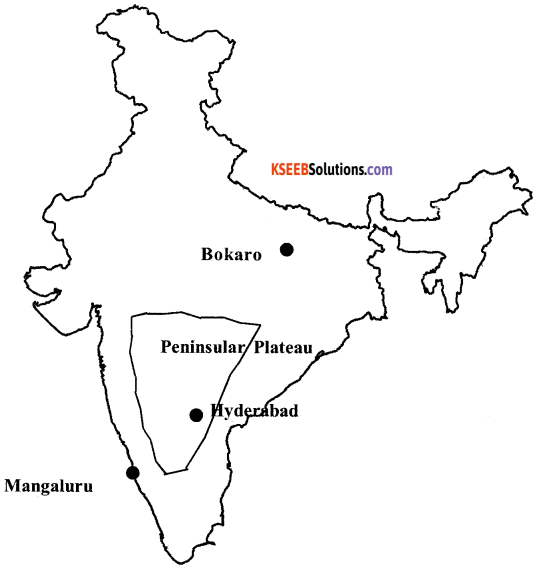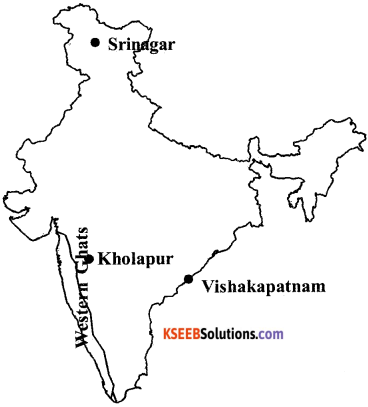Students can Download Karnataka SSLC English Model Question Paper 2 with Answers (1st Language), Karnataka SSLC English Model Question Papers with Answers helps you to revise the complete Karnataka State Board Syllabus and score more marks in your examinations.
Karnataka State Syllabus SSLC English Model Question Paper 2 With Answers (1st Language)
Time: 3 Hours
Max Marks: 100
I. Four alternatives are given for the following questions. Choose the correct answer and write it along with its alphabet. ( 6 × 1 = 6 )
Question 1.
‘That on the ashes of his youth doth lie’. The figure of speech in the line is The figure of speech in the line is
A) Personification
B) Metaphor
C) Synecdoche
D) Alliteration
Answer:
B) Metaphor
Question 2.
There are no snakes in Ireland,______
The appropriate question tag to be added is
A) are they?
B) aren’t they?
C) ain’t they?
D) don’t they?
Answer:
A) are they?
Question 3.
When I was younger, I thought so.
The underlined group of word is
A) a noun clause
B) an adverb clause
C) an adjective clause
D) a main clause
Answer:
B) an adverb clause
![]()
Question 4.
Our boss ______ our meeting until next week
The correct phrasal verb to be filled in the blank is
A) put
B) put off
C) put down
D) put up
Answer:
B) put off
Question 5.
The word in which ‘inter’ is a part of the word but not a prefix is
A) international
B) intercontinatal
C) interpret
D) interact
Answer:
C) interpret
![]()
Question 6.
The bus is coming round the corner
The tense of the verb in the given sentence is
(A) Simple past
(B) Simple present
(C) Past continuous
(D) Present continuous
Answer:
(D) Present continuous
II. Observe the relationship in the first pair of words and complete the second pair accordingly in the following :
( 4 × 1 = 4 )
Question 7.
Sustain : maintain :: imbibe :
Answer:
assimilate / absorb
Question 8.
Blue : blew :: bare :
Answer:
bear
Question 9.
Qualify : disqualify :: responsible :
Answer:
irresponsible
Question 10.
Strength : strong :: mystery :
Answer:
Mysterious
III. Rewrite as directed : ( 3 × 1 = 3 )
Question 11.
Change the voice of sentence :
We are going to watch a movie tonight
Answer:
A movie is going to be watched by us tonight.
![]()
Question 12.
Frame a question to get the underlined words as answer :
You will find the keys on the table
Answer:
Where will I find the keys?
Question 13.
Change to reported speech :
He said, “My mother is a teacher”
Answer:
He told me that his mother is a teacher.
IV. Answer the following questions in a sentence each : ( 4 × 1 = 4 )
Question 14.
When was the male sarus crane shot?
Answer:
The male crane was trying to pull the reluctant sun out of the rim of the horizon.
Question 15.
How was Marion going to identify Gaultier’s Messenger?
Answer:
Gaultier had told Marion that the messenger would ask to kiss her hand and that would be the sign, that the person was the messenger.
Question 16.
What was troubling the French wine growers?
Answer:
The French wine – growers were troubled by a germ which turned their wine sour.
Question 17.
What does ‘moving finger’ mean?
Answer:
Moving finger means fate.
V. Answer the following questions in two – three sentences each : ( 7 × 2 = 14 )
Question 18.
How does a close friend describe Anne when she saw her at the Belsen Camp?
Answer:
The close friend described Anne as ‘cold and hungry’, and her skeleton like form was draped in coarse shapeless, striped garb of the concentration camp.
![]()
Question 19.
What horrid response did the Cyclop give to Ulysses request for hospitality?
Answer:
Polyphemus said nothing in reply but gripping two of Ulysses men standing nearest to him as if they were no more than children, dashed their brains out against the earth, tore in pieces their limbs and devoured them, even while they were warm and trembling, lapping their blood.
Question 20.
Why did the vagabonds go back to the bakery after eating the Pie?
Answer:
When they were waiting at M. Gaultier’s door they saw a tart. They thought that it was a cranberry tart. They felt like it was a tart to dream about, succulent, spiced, sugared and white as a miad’s bosom. They felt that it would be very nice to have it was a starter food before eating the eel pie. So the vagabonds went back to the bakery after eating the pie.
Question 21.
How could the narrator, being blind, describe Mussoorie?
Answer:
At the beginning of the story the narrator himself says that he was totally blind at the time he was travelling by train to Mussoorie. The narrator also tells that the best time to visit Mussoorie was October, when the tourists have gone back and the hills are covered with wild dahlias. We can infer that the narrator’s eyesight was good before and he must have visited Mussoorie many times when he had a good eye sight. But he seems to have lost his eyesight at a recent time.
Question 22.
Why did Buttoo sever his thumb? What does it tell you about Buttoo.
Answer:
Buttoo severed his thumb to present it to his guru Dronacharya as recompense for his skill at archery. It tells as about Buttoo devotion to his guru. He knew that his future was doomed yet he gave up his right thumb.
Question 23.
What has happened to his own garden now with a poison tree? Was he happy in growing a poison tree?
Answer:
The speaker’s garden is no longer a paradise because now, a poisonous tree grows there bearing poisonous fruits. The speaker not happy in growing a poison tree.
![]()
Question 24.
How did Parasurama realize that Kama was not a Brahmana?
Answer:
One day Parasurama was reclining with his head on Kama’s lap when a stinging worm burrowed into Kama’s thigh. Blood began to flow and the pain was terrible, but Kama bore it without tremor lest he should disturb the master’s sleep. Parasurama awoke and saw the blood which had poured from the wound. He said: “Dear pupil, you are not a brahmana. A kshatriya alone can remain unmoved under all bodily torments”.
VI. Rewrite as directed. ( 3 × 2 = 6 )
Question 25.
Change the following sentence to a simple and compound
If you don’t do this you will be punished
Answer:
Simple : Do this to avoid punishment.
Compound : Do this or you will be punished.
Question 26.
Change the following sentence to the other two degrees of comparison :
No other fruit is as sweet as mango.
Answer:
Comparitive : Mango is sweeter than any fruit.
Superalative : Mango is the sweetest of all fruits.
Question 27.
Combine the following sentences using neither / nor
He does not drink. He does not smoke
Answer:
He neither drinks nor smokes.
VII. Answer the following questions in 5-6 sentences each : ( 6 × 3 = 18 )
Question 28.
How does Basavanna console himself regarding his helplessness as a poor man?
Answer:
Basavanna too wants to show his devotion to his Lord. But he was a poor man and could not build temples for his Lord. So he consoles himself saying that his body itself is a temple. His legs are pillars, the body is the shrine where his lord resides and his head is a cupola of gold.
![]()
Question 29.
What was John Silver’s treacherous plan? How did Jim come to know about it?
Answer:
John Silver’s treacherous plan was to kill the skipper, the Squire and the doctor once the treasure was found.
One evening Jim went looking for an apple to eat, but found the apple barrel empty. He climbed right into it and while he was inside the barrel, he over heard, John Silver’s treacherous plan.
Question 30.
Explain how the stones on the wall are disturbed. When is the usual mending time ?
Answer:
- Stones get displaced — swelling due to heavy frost and the upper boulders get spilled in the sun and make wide gaps (natural causes ).
- Hunters disturb the wall when they come searching for rabbits hiding in the gaps of the wall — to please the yelping dogs (man-made causes ).
- Spring — the mending time.
Question 31.
Why does the narrator say that October is the best time in Mussoorie? Being blind, how could he describe it?
Answer:
The narrator was not born blind. He had visited Mussoorie during his childhood. But unfortunately he had lost his sight as he grew – up. Hence he could describe Mussoorie from his memory of the place.
Question 32.
How did Pasteur develop the idea of immunity?
Answer:
Pasteur could understand that a cow could not have anthrax twice. Then he began to wonder whether it would not be possible to make a cow and even a man just a little ill with anthrax, so they might not get it again. Perhaps this could be done by giving cow or sheep very weak old germs to make them safe or immune for the future. This is how he developed the idea of immunity.
![]()
Question 33.
What is the ‘deep irony’ about the tragic comedy of development ? Substantiate your answer with two examples.
Answer:
- Irony : While pockets of private prosperity are growing, there is an inexorable impoverishment of the resources that belong to the public realm.
- Ex. 1 : There is an amazing variety of sleek new car models to choose from but the roads are in bad shape.
- Ex. 2 : Fashionable luxury resorts for the affluent are coming up everywhere whereas lung spaces for public use parks and playgrounds are shrinking.
OR
Write briefly the proceedings of the meeting of the elders in the Workers’ Paradise.
Answer:
- All agreed that work had suffered — people were wasting their precious time in useless things.
- Aerial messenger confessed that it was all because of the wrong man whom he had brought into the paradise.
- The man was summoned — seeing his dress, brushes and paints, they realised this was not the right place for him.
- The President asked him to leave — he agreed readily — the girl of the silent torrent too decided to go with him — All surprised.
VIII. Explain with reference to the context: ( 5 × 3 = 15 )
Question 34.
“But if you’ll unwrap that package you may see why you had me going a while at first”.
Answer:
The words “But if you’ll unwrap that package you may see why you had me going a while at first”, is extracted from the lesson “The gift of the Magi” by O’Henry. The above words are said by Jim to Della, when Della tries to convince Jim why she needed to cut off her hair. Jim comes home and is surprised to see Della without her long hair. Della tries her best to console and convince Jim. Jim finally reveals why he is shocked to see Della without her long hairs by saying the above words.
Question 35.
“Have you noticed that the trees seem to the moving while we seem to be standing still?”
Answer:
The lines are extracted from “The Eyes are not here” by Ruskin Bond.
These lines are spoken by the narrator to the girl travelling with him in the train to Dehradun. The narrator being blind was trying to impress the girl by pretending that he was not blind.
When the girl asked him to look out of the window he moves to the window and pretends looks out and says that the trees outside seemed to be moving while they seem to be standing still.
![]()
Question 36.
Death’s second self, that seals up all
in rest.
Poem — That Time of Year
Poet — William Shakespeare.
Answer:
- Said by poet addressing his friend through the poem.
- The poet imagines himself to be in old age , — wants his friend to love him more as he is nearing death. He corresponds the four stages of man’s life i.e. childhood, youth, old age and death to the four stages of a . day i. e. morning, noon, evening and night and considers night as another name for death because just as death closes all activities of man’s life, similarly night’s darkness closes everything in sleep.
Question 37.
“Money is not required to buy even one necessity of the soul.”
Answer:
This line is taken from the lesson ‘Consumerist Culture’ by Cheriyan Alexander. The Writer has quoted this sentence made by Henry David Thoreau, the 19th C American philosopher. It is quoted to impress the fact that beyond a point it is necessary to say ‘enough’ to more meterial wealth. Even if we acquire all the material wealth we do not feel satisfied. But to gain, spiritual knowledge, no money is required. Hence “Money is not required to buy even one necessity of the soul”.
Question 38.
“I didn’t want to catch the darned thing’.
Lesson : A village Cricket Match
Author : A.G Macdonell
Said by Boone to Donald.
Answer:
The sexton of the village team, a man of Iron muscle from much digging hit the ball and it flashed like a thunderbolt straight at Donald. He sprang backwards to avoid it. The ball went straight and hit mighty Boone in the mid – riff like a red – hot cannon ball upon a Spanish Galleon. With a fearful oath, Boone clapped his hands to his outraged stomach and found that the ball was in the way.
He looked at it for a moment and in astonishment and then threw it down angrily. Donald came up to him and congratulted him for the catch. Boone scowled at him and told him that he didn’t want to catch the darned ball; sourly massaging his enraged stomach.
IX. Quote from memory: ( 1 × 4 = 4 )
Question 39.
So boldly he enter’d the Netherby Hall.
Among bride’s – men, and kinsmen,
and brothers and all:
Then spoke the bride’s father, his hand on
his sword
(For the poor craven bridegroom said never a word).
“O come ye in peace here, or come ye in war
OR
The rich
will make temples for Siva.
What shall I,
a poor man,
do?
My legs are pillars,
the body the shrine,
the head a cupola
of gold.
![]()
X. Answer the following questions in seven to eight sentences each : ( 3 × 4 = 12 )
Question 40.
What does the poet- father want his son’s teacher to teach his son about-
a) Books and Nature?
b) Being honest?
Answer:
The poet father wants his son’s teacher to teach him all the values essential for his son to lead a virtuous life,
a) Books and Nature: The poet requests {he teacher to teach his son the wonder of books. He should be given quiet time to think about the mysteries and wonders of nature- the birds in the sky; the bees in the sun flowers on a green hill side.
b) Being honest: The teacher should teach him that it more honorable to fail than cheat. He/she should teach him the value of a dollar earned is far greater than five dollars found.
Question 41.
“The ball hit by the Sexton flashed like a thunderbolt.” Describe the scene where the fielder tried to catch it.
Answer:
After the postman had gone back to the pavilion, the scores were level with only two wickets to fall. Then the Major bowled a fast half – volley on the leg – stump. The sexton hit it fair and square in the middle of the bat and it flashed like a thunderbolt, waist – high, straight at the youth in the blue jumper.
The youth sprang backwards out of its way and fell over on his back. Immediately behind him stood the mighty Boone. There was no escape for him. The ball struck him in the midriff (stomach) like a red hot cannon ball upon a Spanish sailing ship and with the sound of a drumstick upon an insufficiently stretched drum.
With a curse, Boone clasped his hand to his stomach and found that the ball was in his hands. He threw it down angrily and massaged the injured spot. Hence he did not reciprocate cordially when Donald congratulated him.
‘Midriff’ refers to the belly of Boone. The ball is likened to a red – hot cannon ball that hit a Spanish ship. ‘An insufficiently stretched drum’ refers to Boone’s big belly.Thus, the whole description is a comical caricature of Boone, and the ‘hit’ that he received in the belly, like the one given here, contributes to the element of humour.
OR
Narrate the instances to show how the narrator tried his best to prove to the girl that he was normal sighted.
Answer:
As soon as the girl enters the compartment, the young man asks her whether she was going all the way to Dehradun. When the girl expresses her surprise and tries to hide the fact that she was blind saying “I didn’t know anyone else was here”, the young man in his enthusiasm to prove her that he was normal sighted tells her, “I didn’t see you either, but I heard you come in”.
Had the young man been confident enough he should not have made the statement, but he was guilty that he was blind and so makes an attempt to cover up his fault.
When the girl learns that he was going to Mussoorie, she tells him that he is luckly and that she loves the hills especially in October. The young man recalls from memory his previous visits to Mussoorie and conveys his approval that October was the best time to visit Mussoorie. Then he gives a beautiful description of the natural scenery in Mussoorie only to let her know that he was normal sighted like any other person.
Next, he tells the girl that she had an interesting face only to flatter her.
Question 42.
Man today is an unstoppable buying machine. Elucidate with examples.
Answer:
Man today is an unstoppable buying machine. Shopping has become more than a need. For increasing numbers of people today, it has become the chief form of entertainment, an obsessive compulsion they have little control over, and often an end in itself. Relentless advertisements persuade people to become buying machines incapable of figuring out how much of all those things they really need.
In a recent survey conducted in the U.S it was discovered that most Americans spend roughly half their leisure time watching T.V and the other half spend their time shopping, the sheer amount of choices available has thrilled shoppers and they have turned into voracious shoppers.
OR
Write on the appropriateness of the title ‘The Gift of the Magi’.
Answer:
“The Gift of the Magi” is a story in which a young couple excels in their giving gift one to another. The author compares their giving the gifts the Magi gave to baby Jesus. The Three Wise men knew how to give. They gave unique gifts with special emphasis. Jim and Della have given special gifts to one another. They made the ultimate sacrifice. They gave their most prized possession.
Truly, no other couple has been compared to The Three Wise Men and their giving of themselves. The author of “The Gift of the Magi” beautifully writes how Jim and Della pay the price by giving up valuable gifts to show their love for one another.
No greater love is expressed than the love Jim and Della have for each other. Their gifts display their unselfish attitudes. Jim and Della care deeply and each one’s gifts expressing a genuine desire to please the other.
No doubt, Jim and Della are the Magi: The narrator explains that the wise men, or Magi, , brought gifts to the baby Jesus and so invented the giving of Christmas gifts. Because these men were wise, they no doubt gave wise gifts. Della and Jim, the narrator asserts, have unwisely sacrificed their most precious possessions. Yet, because they gave from the heart, they are wise: “They are the Magi.”
![]()
XI. 43. Read the following passage carefully and answer the questions given below : 1 × 4 = 4 ( 2 × 2 )
It is everyone’s desire to have a personality that is appreciated by all. Personality is the combination of physical, emotional, spiritual and psychological aspects in a person. If you wish to enhance your personality, start by respecting yourself and believing in your ability to win respect from others. Have a positive attitude. In your interaction with other be polite and gentle, doing good to them and for them as far as possible.
Give importance to words. Speak only when it is required and is of utmost necessity. What you say has tremendous power. it can hurt, it can heal, it can charm or it can harm. A kind word can support a person, motivate him and make him feel good. Be devoted and committed to your work.
Remember you are always a learner even when you have climbed up the ladder of position and success. The higher you reach, the more humble you should be. The meaning of life is to grow, but grow with changes for the better. Your personality shows when you a positive outlook, the right communication, a commitment to work, the will to serve others and humble acceptance of success.
Questions:
A) What aspects are included in a personality?
Answer:
Physical, emotional, spiritual and psychological aspects.
B) What is the first step to enhance your personality?
Answer:
Respecting oneself and believing in one’s ability to win respect from others.
XII. 44. Write an essay of about 18-20 sentences on any one of the following topics: ( 1 × 5 = 5 )
(a) Role of an ideal Citizen.
Answer:
An ideal citizen is the one who is aware of his duties even as he exercises his rights. The constitution of India has assured us both right and duties. But unfortunately, most of us enjoy our rights without fulfilling our duties. So, we can say that ideal citizen is the one who prioritises his duties over his rights.
What are the duties to be upheld by an ideal citizen? First and foremost, an ideal citizen is the one who loves his country and who is proud of his country. So he should promote secularism and bring people of different communities together in the true spirit of brotherhood.
The word ‘brotherhood’ points out that in society all of us should get equal opportunities. So an ideal citizen would strive to ensure that there is social justice and people get equal benefit without a huge gap between the rich and the poor. An ideal citizen should exhibit the virtue of philanthropy and social consciousness.
In addition to these lofty ideals, an ideal citizen should also keep in mind practical values like saving the environment, preserving natural resources, keeping the surroundings clean and protecting public amenities.
If each one of us does what is expected of an ideal citizen, this world certainly be a better place to live in and we can experience the heaven on the earth.
(b) Indian farmer today.
Answer:
Indian farmers today are at the cross roads. Technology has taken huge strides reformulating the role of farmers. If farmers do not make use of technology, they would be left behind in this fast – moving world, That is why, it is of paramount importance that Indian farmers educate themselves and know how to succeed in the new world order of consumerism.
If they are educated, they can progress in the field of agriculture and contribute richly towards the economy of the nation. Even to this day, despite the progress it has made in the IT Sector, India is recognised as an agricultural economy. Hence it is of paramount importance that India values its farmers.
But unfortunately we have seen that Indian farmers are native, and hence are taken for a ride by the mediators. That is why there are many tragic cases of farmers committing suicide after being cheated by mediators who swallow a lion’s share of farmers profit margin or landlords who offer loans on high rates of interest.
It is the duty of the government to offer attractive schemes of farmers so that the nation makes progress in the field of agriculture. It is also necessary that the government educates farmers and also gives manure and farming equipment at subsidised rates.
This would mean a bright future for India.
![]()
XIII. 45. Imagine that you are Punith / Parineetha studying in Government High School, Udupi.
Write a letter to the local Electricity Board to reduce the power – cuts during evening stating reasons. ( 1 x 5 = 5 )
Answer:
Punith
Govt. High school
Udupi
Date : ………..
The Chief Engineer
Urban sub- division
MESCOM
Udupi
Dear Sir,
This is to bring to your attention the problems faced by the residents of Vidyaratna Nagar. For the past two months we have been facing power – cuts of long duration both in the mornings and evenings, we take strong objection to the power cuts in the evenings. While it is understandable that the production of electricity is insufficient, and has led to unavoidable power cuts, it is not acceptable that there is no uniformity in the power cuts in different areas. It is also objectionable that factories which consume much mote electricity than residences have not been affected.
The school – going children have faced terrible problems with power – cuts. There is the question of safety too as the whole area is dark to power – cuts. Unfortunately, the rich can manage with inverters and generators. It is the poor who suffer.
We have lodged complaints twice before. But no action has been taken. We request you to act upon our complaint immediately and ensure that the power – cuts in the evenings are stopped.
Thank You.
Yours faithfully
Punith
OR
Write a letter to your elder brother/ sister thanking him/ her for preparing you for the inter-state debate competition in which you the first prize.
Answer:
Govt. High School
Udupi
Date : ……….
Dear Akka,
I am very happy to share with you a piece of good news. Remember, you helped me for a debate competition last months? I sought your help because it was an inter – state debate competition. Had it been merely an inter – school competition, I wouldn’t have probably troubled you because I know how busy you are in your job.. I know that your work stretches for more than 12 hours. Yet you made time for me and I am proud that I kept faith. Akka, I won the first prize.
Do you know something? It is a cash prize of Rs. 5000 Actually, I should give more than half the amount to you as you gave me all the points. One of the judges even told me that my presentation was superior to that of others, not in the delivery, but in the content… So, thank you once again Akka.
In my excitement of being a winner I forgot to ask you about Kathak recital. How did the programme go on? I am sure you were the star performer of the evening. Do let me know all the details when you find some time
Thanking you.
Loads of love.
Parineetha.
